Sasanian Empire
Ērānšahr 𐭠𐭩𐭥𐭠𐭭𐭱𐭲𐭥𐭩(Middle Persian) | |
|---|---|
| 224–651 | |
Derafsh Kaviani
(royal standard) Simurgh
(imperial emblem) | |
 The Sasanian Empire at its greatest extent,c. 620,underKhosrow II | |
| Capital | |
| Common languages | Middle Persian(official)[2] Other languages |
| Religion | |
| Government | Feudalmonarchy[3] |
| Shahanshah | |
• 224–241 | Ardashir I(first) |
• 632–651 | Yazdegerd III(last) |
| Historical era | Late Antiquity |
| 28 April 224 | |
• TheIberian War | 526–532 |
| 602–628 | |
| 628–632 | |
| 633–651 | |
| 651 | |
| Area | |
| 550[5][6] | 3,500,000 km2(1,400,000 sq mi) |
| History ofIran |
|---|
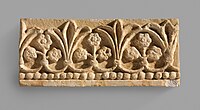 |
|
Timeline |
TheSasanian Empire(/səˈsɑːniən,səˈseɪniən/) orSassanid Empire,also known as theSecond Persian Empire,[7][8]and officially known asĒrānšahr( "Land/Empire of the Iranians" ),[9][10][a]was thelast Iranian empirebefore theearly Muslim conquestsof the 7th to 8th centuries. Named after theHouse of Sasan,it endured for over four centuries, from 224 to 651, making it the second longest-livedPersian imperial dynastyafter the Arsacids of theParthian Empire.[12][13]
The Sasanian Empire succeeded the Parthian Empire and re-established thePersiansas a major power inlate antiquityalongside its arch-rival, theRoman Empire(after 395 theByzantine Empire).[14][15][16]The empire ended with theMuslim conquest of Persia.It was founded byArdashir I,a ruler who rose to power as Parthia weakened as a result of internal strife and wars with the Romans. After defeating the last ParthianKing of Kings,Artabanus IV,at theBattle of Hormozdganin 224, he established the Sasanian Empire and set out to restore the legacy of theAchaemenid Empireby expanding Persia's dominions.
At its greatest territorial extent, the Sasanian Empire encompassed all of present-dayIranandIraq,and stretched from theLevantto theIndian subcontinentand fromSouth Arabiato theCaucasusandCentral Asia.
The period of Sasanian rule was a high point in Iranian civilization,[17]characterized by a complex and centralized government bureaucracy, and revitalizedZoroastrianismas a legitimizing and unifying ideal.[18]They also built grand monuments, public works, and patronized cultural and educational institutions. The empire's cultural influence extended far beyond its territorial borders, includingWestern Europe,[19]Africa,[20]China,andIndia[21]—and helped shapeEuropeanandAsianmedieval art.[22]
Following theearly Muslim conquests,the influence ofSasanian art,architecture,music,literatureandphilosophyonIslamic cultureensured the spread of Iranian culture, knowledge and ideas throughout theMuslim world.[23]
Name
Officially, the empire was known as the Kingdom of theIranians(Middle Persian:ērānšahr,Parthian:aryānšahr,Greek:Arianōn ethnos); the term is first attested in the trilingualGreat Inscription of Shapur I,where thekingsays "I am the lord of the Realm of the Iranians".[b][24]
More commonly, as theruling dynastywas named afterSasan,the empire is known as the Sasanian Empire in historical and academic sources. This term is also recorded in English as theSassanian Empire,theSasanid Empire,and theSassanid Empire.Historians have referred to the Sasanian Empire as theNeo-Persian Empire,since it was the second Iranian empire that rose fromPars(Persis),[25]while theAchaemenid Empirewas the first.
History
Origins and early history (205–310)
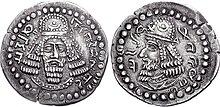
Obv:Bearded facing head, wearing diadem and Parthian-style tiara, legend"The divine Ardaxir, king"in Pahlavi.
Rev:Bearded head ofPapak,wearing diadem and Parthian-style tiara, legend"son of the divinity Papak, king"in Pahlavi.
Conflicting accounts shroud the details of the fall of theParthian Empireand subsequent rise of the Sassanian Empire in mystery.[26]The Sassanian Empire was established inEstakhrbyArdashir I.
Ardashir's father,Papak,was originally the ruler of a region called Khir. However, by 200, Papak had managed to overthrowGochihrand appoint himself the new ruler of theBazrangids.Papak's mother, Rodhagh, was the daughter of the provincial governor ofPars.Papak and his eldest son Shapur managed to expand their power over all of Pars. Subsequent events are unclear due to the elusive nature of the sources. It is certain that following the death of Papak, Ardashir, the governor ofDarabgerd,became involved in a power struggle with his elder brother Shapur. Sources reveal that Shapur was killed when the roof of a building collapsed on him. By 208, over the protests of his other brothers, who were put to death, Ardashir declared himself ruler of Pars.[27][28]
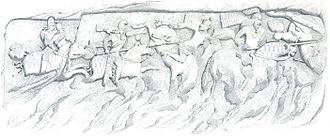
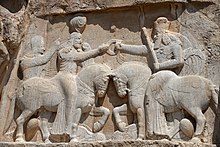
Once Ardashir was appointedshah(king), he moved his capital further to the south of Pars and foundedArdashir-Khwarrah(formerlyGur,modern dayFiruzabad). The city, well protected by high mountains and easily defensible due to the narrow passes that approached it, became the center of Ardashir's efforts to gain more power. It was surrounded by a high, circular wall, probably copied from that of Darabgerd. Ardashir's palace was on the north side of the city; remains of it are extant. After establishing his rule over Pars, Ardashir rapidly extended his territory, demanding fealty from the local princes of Fars, and gaining control over the neighbouring provinces ofKerman,Isfahan,SusianaandMesene.This expansion quickly came to the attention of Artabanus IV, the Parthian king, who initially ordered the governor of Khuzestan to wage war against Ardashir in 224, but Ardashir was victorious in the ensuing battles. In a second attempt to destroy Ardashir, Artabanus himself met Ardashir in battle at Hormozgan, where the former met his death. Following the death of the Parthian ruler, Ardashir went on to invade the western provinces of the now defunct Parthian Empire.[29]
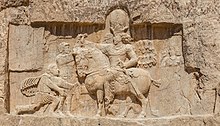
At that time the Arsacid dynasty was divided between supporters ofArtabanus IVandVologases VI,which probably allowed Ardashir to consolidate his authority in the south with little or no interference from the Parthians. Ardashir was aided by the geography of the province of Fars, which was separated from the rest of Iran.[30]Crowned in 224 atCtesiphonas the sole ruler of Persia, Ardashir took the titleshahanshah,or "King of Kings" (the inscriptions mentionAdhur-Anahidas hisBanbishnan banbishn,"Queen of Queens", but her relationship with Ardashir has not been fully established), bringing the 400-year-old Parthian Empire to an end, and beginning four centuries of Sassanid rule.[31]
In the next few years, local rebellions occurred throughout the empire. Nonetheless, Ardashir I further expanded his new empire to the east and northwest, conquering the provinces ofSakastan,Gorgan,Khorasan,Marw(in modernTurkmenistan),BalkhandChorasmia.He also addedBahrainandMosulto the Sassanid possessions. Later Sassanid inscriptions also claim the submission of the kings ofKushan,TuranandMakuranto Ardashir, although based on numismatic evidence it is more likely that these actually submitted to Ardashir's son, the futureShapur I.In the west, assaults againstHatra,ArmeniaandAdiabenemet with less success. In 230, Ardashir raided deep into Roman territory, and a Roman counter-offensive two years later ended inconclusively. Ardashīr began leading campaigns into Greater Khurasan as early as 233, extending his power to Khwarazm in the north and Sistan in the south while capturing lands from Gorgan to Abarshahr, Marw, and as far east asBalkh.[32]
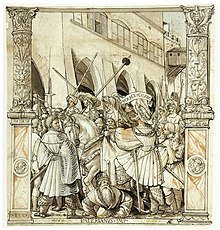
Ardashir I's son Shapur I continued the expansion of the empire, conqueringBactriaand the western portion of the Kushan Empire, while leading several campaigns against Rome. InvadingRoman Mesopotamia,Shapur I capturedCarrhaeandNisibis,but in 243 the Roman generalTimesitheusdefeated the Persians atRhesainaand regained the lost territories.[33]The emperorGordian III's (238–244) subsequent advance down theEuphrateswas defeated atMeshike(244), leading to Gordian's murder by his own troops and enabling Shapur to conclude a highly advantageous peace treaty with the new emperorPhilip the Arab,by which he secured the immediate payment of 500,000denariiand further annual payments.
Shapur soon resumed the war, defeated the Romans atBarbalissos(253), and then probably took and plunderedAntioch.[33][34]Roman counter-attacks under the emperorValerianended in disaster when the Roman army was defeated and besieged atEdessaand Valerian was captured by Shapur, remaining his prisoner for the rest of his life. Shapur celebrated his victory by carving the impressive rock reliefs inNaqsh-e RostamandBishapur,as well as a monumental inscription in Persian andGreekin the vicinity ofPersepolis.He exploited his success by advancing intoAnatolia(260), but withdrew in disarray after defeats at the hands of the Romans and theirPalmyreneallyOdaenathus,suffering the capture of his harem and the loss of all the Roman territories he had occupied.[35][36]

Shapur had intensive development plans. He ordered the construction of thefirst dam bridge in Iranand founded many cities, some settled in part by emigrants from the Roman territories, including Christians who could exercise their faith freely under Sassanid rule. Two cities,BishapurandNishapur,are named after him. He particularly favouredManichaeism,protectingMani(who dedicated one of his books, theShabuhragan,to him) and sent many Manichaean missionaries abroad. He also befriended aBabylonianrabbi calledSamuel.
This friendship was advantageous for theJewishcommunity and gave them a respite from the oppressive laws enacted against them. Later kings reversed Shapur's policy of religious tolerance. When Shapur's sonBahram Iacceded to the throne, he was pressured by theZoroastrianhigh-priestKartirBahram Ito kill Mani and persecute his followers.Bahram IIwas also amenable to the wishes of the Zoroastrian priesthood.[38][39]During his reign, the Sassanid capital Ctesiphon was sacked by the Romans under EmperorCarus,and most of Armenia, after half a century of Persian rule, was ceded toDiocletian.[40]
SucceedingBahram III(who ruled briefly in 293),Narsehembarked on another war with the Romans. After an early success against the EmperorGaleriusnearCallinicumon the Euphrates in 296, he was eventually decisively defeated by them. Galerius had been reinforced, probably in the spring of 298, by a new contingent collected from the empire'sDanubianholdings.[41]Narseh did not advance from Armenia andMesopotamia,leaving Galerius to lead the offensive in 298 with an attack on northern Mesopotamia via Armenia. Narseh retreated to Armenia to fight Galerius's force, to the former's disadvantage: the rugged Armenian terrain was favourable to Roman infantry, but not to Sassanid cavalry. Local aid gave Galerius the advantage of surprise over the Persian forces, and, in two successive battles, Galerius secured victories over Narseh.[42]

During the second encounter, Roman forces seized Narseh's camp, his treasury, his harem, and his wife.[42]Galerius advanced intoMediaandAdiabene,winning successive victories, most prominently nearErzurum,and securing Nisibis (Nusaybin,Turkey) before 1 October 298. He then advanced down theTigris,taking Ctesiphon. Narseh had previously sent an ambassador to Galerius to plead for the return of his wives and children. Peace negotiations began in the spring of 299, with both Diocletian and Galerius presiding.
The conditions of the peace were heavy: Persia would give up territory to Rome, making the Tigris the boundary between the two empires. Further terms specified that Armenia was returned to Roman domination, with the fort of Ziatha as its border;Caucasian Iberiawould pay allegiance to Rome under a Roman appointee; Nisibis, now under Roman rule, would become the sole conduit for trade between Persia and Rome; and Rome would exercise control over the five satrapies between the Tigris and Armenia:Ingilene,Sophanene (Sophene), Arzanene (Aghdznik),Corduene,andZabdicene(near modernHakkâri,Turkey).[43]
The Sassanids ceded five provinces west of the Tigris, and agreed not to interfere in the affairs of Armenia and Georgia.[44]In the aftermath of this defeat, Narseh gave up the throne and died a year later, leaving the Sassanid throne to his son,Hormizd II.Unrest spread throughout the land, and while the new king suppressed revolts inSakastanand Kushan, he was unable to control the nobles and was subsequently killed byBedouinson a hunting trip in 309.
First Golden Era (309–379)

Following Hormizd II's death, northern Arabs started to ravage and plunder the western cities of the empire, even attacking the province of Fars, the birthplace of the Sassanid kings. Meanwhile, Persian nobles killed Hormizd II's eldest son, blinded the second, and imprisoned the third (who later escaped into Roman territory). The throne was reserved forShapur II,the unborn child of one of Hormizd II's wives who was crownedin utero:the crown was placed upon his mother's stomach.[45]During his youth the empire was controlled by his mother and the nobles. Upon coming of age, Shapur II assumed power and quickly proved to be an active and effective ruler.
He first led his small but disciplined army south against the Arabs, whom he defeated, securing the southern areas of the empire.[46]He then began his first campaign against the Romans in the west, where Persian forces won a series of battles but were unable to make territorial gains due to the failure of repeated sieges of the key frontier city of Nisibis, and Roman success in retaking the cities ofSingaraandAmidaafter they had previously fallen to the Persians.
These campaigns were halted by nomadic raids along the eastern borders of the empire, which threatenedTransoxiana,a strategically critical area for control of theSilk Road.Shapur therefore marched east toward Transoxiana to meet the eastern nomads, leaving his local commanders to mount nuisance raids on the Romans.[47]He crushed the Central Asian tribes, and annexed the area as a new province.
In the east around 325,Shapur IIregained the upper hand against theKushano-Sasanian Kingdomand took control of large territories in areas now known asAfghanistanandPakistan.Cultural expansion followed this victory, and Sasanian art penetratedTransoxiana,reaching as far as China. Shapur, along with the nomad KingGrumbates,started his second campaign against the Romans in 359 and soon succeeded in retaking Singara and Amida. In response the Roman emperorJulianstruck deep into Persian territory and defeated Shapur's forces atCtesiphon.He failed to take the capital, however, and was killed while trying to retreat to Roman territory.[48]His successorJovian,trapped on the east bank of the Tigris, had to hand over all the provinces the Persians had ceded to Rome in 298, as well as Nisibis and Singara, to secure safe passage for his army out of Persia.
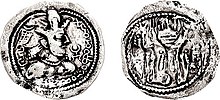
 and "Alchono" (αλχοννο) inBactrian scripton theobverse.Dated 400–440.[49]
and "Alchono" (αλχοννο) inBactrian scripton theobverse.Dated 400–440.[49]From around 370, however, towards the end of the reign ofShapur II,the Sasanians lost the control ofBactriato invaders from the north: first theKidarites,then theHephthalitesand finally theAlchon Huns,who would follow up with an invasion ofIndia.[50]These invaders initially issued coins based on Sasanian designs.[51]Various coins minted in Bactria and based on Sasanian designs are extant, often with busts imitating Sassanian kings Shapur II (r. 309 to 379) andShapur III(r. 383 to 388), adding the AlchonTamghaand the name "Alchono" inBactrian scripton the obverse, and with attendants to afire altaron the reverse.[52]
Shapur II pursued a harsh religious policy. Under his reign, the collection of theAvesta,the sacred texts of Zoroastrianism, was completed,heresyandapostasywere punished, and Christians were persecuted. The latter was a reaction against theChristianizationof the Roman Empire byConstantine the Great.Shapur II, like Shapur I, was amicable towardsJews,who lived in relative freedom and gained many advantages during his reign.[c]At the time of his death, the Persian Empire was stronger than ever, with its enemies to the east pacified andArmeniaunder Persian control.[48]
Intermediate Era (379–498)
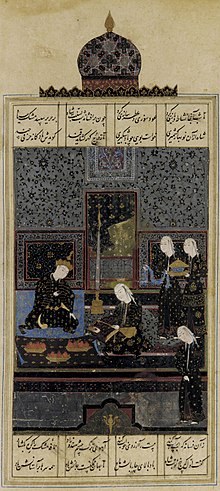
From Shapur II's death untilKavad I's first coronation, there was a largely peaceful period with the Romans (by this time theEastern RomanorByzantine Empire) engaged in just two brief wars with the Sassanian Empire, thefirst in 421–422and thesecond in 440.[53][54][55][56]Throughout this era, Sasanian religious policy differed dramatically from king to king. Despite a series of weak leaders, theadministrative systemestablished during Shapur II's reign remained strong, and the empire continued to function effectively.[53]
After Shapur II died in 379, the empire passed on to his half-brotherArdashir II(379–383; son of Hormizd II) and his sonShapur III(383–388), neither of whom demonstrated their predecessor's skill in ruling.Bahram IV(388–399) also failed to achieve anything important for the empire. During this time Armenia was divided by a treaty between the Roman and Sasanian empires. The Sasanians reestablished their rule over Greater Armenia, while the Byzantine Empire held a small portion of western Armenia.
Bahram IV's sonYazdegerd I(399–421) is often compared toConstantine I.Both were physically and diplomatically powerful, opportunistic, practiced religious tolerance and provided freedom for the rise of religious minorities. Yazdegerd stopped the persecution against the Christians and punished nobles and priests who persecuted them. His reign marked a relatively peaceful era with the Romans, and he even took the youngTheodosius II(408–450) under his guardianship. Yazdegerd also married a Jewish princess, who bore him a son called Narsi.
Yazdegerd I's successor was his sonBahram V(421–438), one of the most well-known Sasanian kings and the hero of many myths. These myths persisted even after the destruction of the Sasanian Empire by the Arabs. Bahram gained the crown after Yazdegerd's sudden death (or assassination), which occurred when the grandees opposed the king with the help ofal-Mundhir,the Arabic dynast ofal-Hirah.Bahram's mother wasShushandukht,the daughter of the JewishExilarch.In 427, he crushed an invasion in the east by the nomadicHephthalites,extending his influence into Central Asia, where his portrait survived for centuries on the coinage ofBukhara(in modernUzbekistan). Bahram deposed the vassal king of the Iranian-held area ofArmeniaand made it a province of the empire.
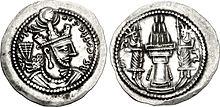
Bahram V's sonYazdegerd II(438–457) was in some ways a moderate ruler, but, in contrast to Yazdegerd I, he practised a harsh policy towards minority religions, particularlyChristianity.[57]However, at theBattle of Avarayrin 451, theArmenian subjectsled byVardan Mamikonianreaffirmed Armenia's right to profess Christianity freely.[58][59]This was to be later confirmed by theNvarsak Treaty(484).
At the beginning of his reign in 441, Yazdegerd II assembled an army of soldiers from various nations, including his Indian allies, and attacked theByzantine Empire,but peace was soon restored after some small-scale fighting. He then gathered his forces inNishapurin 443 and launched a prolonged campaign against theKidarites.After a number of battles he crushed them and drove them out beyond theOxus riverin 450.[60]During his eastern campaign, Yazdegerd II grew suspicious of the Christians in the army and expelled them all from the governing body and army. He then persecuted the Christians in his land, and, to a much lesser extent, theJews.[61]In order to reestablish Zoroastrianism in Armenia, he crushed an uprising of Armenian Christians at theBattle of Vartanantzin 451. The Armenians, however, remained primarily Christian. In his later years, he was engaged yet again with the Kidarites right up until his death in 457.Hormizd III(457–459), the younger son of Yazdegerd II, then ascended to the throne. During his short rule, he continually fought with his elder brotherPeroz I,who had the support of the nobility,[61]and with the Hephthalites inBactria.He was killed by his brother Peroz in 459.

At the beginning of the 5th century, the Hephthalites (White Huns), along with other nomadic groups, attacked Iran. At first Bahram V and Yazdegerd II inflicted decisive defeats against them and drove them back eastward. The Huns returned at the end of the 5th century and defeated Peroz I (457–484) in 483. Following this victory, the Huns invaded and plundered parts of eastern Iran continually for two years. They exacted heavy tribute for some years thereafter.
These attacks brought instability and chaos to the kingdom. Peroz tried again to drive out the Hephthalites, but on the way toBalkhhis army was trapped by the Huns in the desert. Peroz wasdefeated and killedby a Hephthalite army near Balkh.[62][63]His army was completely destroyed, and his body was never found.[64]Four of his sons and brothers had also died.[65]The main Sasanian cities of the eastern region ofKhorasan−Nishapur,HeratandMarwwere now under Hephthalite rule.[63]Sukhra,a member of the ParthianHouse of Karen,one of theSeven Great Houses of Iran,quickly raised a new force and stopped the Hephthalites from achieving further success.[66]Peroz' brother,Balash,was elected as shah by the Iranian magnates, most notably Sukhra and theMihranidgeneralShapur Mihran.[67]
Balash (484–488) was a mild and generous monarch, and showed care towards his subjects, including the Christians.[68]However, he proved unpopular among the nobility and clergy who had him deposed after just four years in 488.[68]Sukhra, who had played a key role in Balash's deposition,[68]appointed Peroz' sonKavad Ias the new shah of Iran.[69]According toMiskawayh(d. 1030), Sukhra was Kavad's maternal uncle.[63]Kavad I (488–531) was an energetic and reformist ruler. He gave his support to the sect founded byMazdak,son of Bamdad, who demanded that the rich should divide their wives and their wealth with the poor. By adopting the doctrine of the Mazdakites, his intention evidently was to break the influence of the magnates and the growing aristocracy. These reforms led to his being deposed and imprisoned in theCastle of OblivioninKhuzestan,and his younger brotherJamasp(Zamaspes) became king in 496. Kavad, however, quickly escaped and was given refuge by the Hephthalite king.[70][71]
Jamasp(496–498) was installed on the Sasanian throne upon the deposition of Kavad I by members of the nobility. He was a good and kind king; he reduced taxes in order to improve the condition of thepeasantsand the poor. He was also an adherent of the mainstream Zoroastrian religion, diversions from which had cost Kavad I his throne and freedom. Jamasp's reign soon ended, however, when Kavad I, at the head of a large army granted to him by the Hephthalite king, returned to the empire's capital. Jamasp stepped down from his position and returned the throne to his brother.[72]No further mention of Jamasp is made after the restoration of Kavad I, but it is widely believed that he was treated favourably at the court of his brother.[73]
Second Golden Era (498–622)

The second golden era began after the second reign of Kavad I. With the support of theHephthalites,Kavad launched a campaign against the Romans. In 502, he tookTheodosiopolisin Armenia, but lost it soon afterwards. In 503 he tookAmidaon the Tigris. In 504, an invasion of Armenia by the western Huns from the Caucasus led to an armistice, the return of Amida to Roman control and a peace treaty in 506. In 521/522 Kavad lost control ofLazica,whose rulers switched their allegiance to the Romans; an attempt by theIberiansin 524/525 to do likewise triggered a war between Rome and Persia.
In 527, a Roman offensive against Nisibis was repulsed and Roman efforts to fortify positions near the frontier were thwarted. In 530, Kavad sent an army underPerozesto attack the important Roman frontier city ofDara.The army was met by the Roman generalBelisarius,and, though superior in numbers, was defeated at theBattle of Dara.In the same year, a second Persian army underMihr-Mihroewas defeated atSatalaby Roman forces underSittasand Dorotheus, but in 531 a Persian army accompanied by aLakhmidcontingent underAl-Mundhir IIIdefeated Belisarius at theBattle of Callinicum,and in 532 an "eternal" peace was concluded.[74]Kavad succeeded in restoring order in the interior and fought with general success against the Eastern Romans, founded several cities, some of which were named after him, and began to regulate taxation and internal administration.
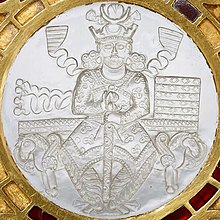
After the reign of Kavad I, his sonKhosrow I,also known as Anushirvan ( "with the immortal soul"; ruled 531–579), ascended to the throne. He is the most celebrated of the Sassanid rulers. Khosrow I is most famous for his reforms in the aging governing body of Sassanids. He introduced a rational system oftaxationbased upon a survey oflanded possessions,which his father had begun, and he tried in every way to increase the welfare and the revenues of his empire. Previous great feudal lords fielded their own military equipment, followers, and retainers. Khosrow I developed a new force ofdehqans,or "knights", paid and equipped by the central government[75]and the bureaucracy, tying the army and bureaucracy more closely to the central government than to local lords.[76]
EmperorJustinian I(527–565) paid Khosrow I 440,000 pieces of gold as a part of the "eternal peace" treaty of 532. In 540, Khosrow broke the treaty and invaded Syria, sacking Antioch and extorting large sums of money from a number of other cities. Further successes followed: in 541 Lazica defected to the Persian side, and in 542 a major Byzantine offensive inArmeniawas defeated atAnglon.Also in 541,Khosrow Ientered Lazica at the invitation of its king, captured the main Byzantine stronghold atPetra,and established another protectorate over the country,[77]commencing theLazic War.A five-year truce agreed to in 545 was interrupted in 547 when Lazica again switched sides and eventually expelled its Persian garrison with Byzantine help; the war resumed but remained confined to Lazica, which was retained by the Byzantines when peace was concluded in 562.
In 565, Justinian I died and was succeeded byJustin II(565–578), who resolved to stop subsidies to Arab chieftains to restrain them from raiding Byzantine territory in Syria. A year earlier, the Sassanid governor of Armenia,Chihor-Vishnaspof the Suren family, built a fire temple atDvinnear modernYerevan,and he put to death an influential member of theMamikonianfamily, touching off a revolt which led to the massacre of the Persian governor and his guard in 571, while rebellion also broke out inIberia.Justin II took advantage of the Armenian revolt to stop his yearly payments to Khosrow I for the defense of the Caucasus passes.
The Armenians were welcomed as allies, and an army was sent into Sassanid territory whichbesiegedNisibis in 573. However, dissension among the Byzantine generals not only led to an abandonment of the siege, but they in turn were besieged in the city ofDara,which was taken by the Persians. Capitalizing on this success, the Persians then ravaged Syria, causing Justin II to agree to make annual payments in exchange for a five-year truce on the Mesopotamian front, although the war continued elsewhere. In 576 Khosrow I led his last campaign, an offensive into Anatolia which sackedSebasteiaandMelitene,but ended in disaster: defeated outside Melitene, the Persians suffered heavy losses as they fled across the Euphrates under Byzantine attack. Taking advantage of Persian disarray, the Byzantines raided deep into Khosrow's territory, even mounting amphibious attacks across theCaspian Sea.Khosrow sued for peace, but he decided to continue the war after a victory by his generalTamkhosrowin Armenia in 577, and fighting resumed in Mesopotamia. The Armenian revolt came to an end with a general amnesty, which brought Armenia back into the Sassanid Empire.[75]
Around 570, "Ma 'd-Karib", half-brother of the King of Yemen, requested Khosrow I's intervention. Khosrow I sent a fleet and a small army under a commander calledVahrizto the area near presentAden,and they marched against the capital San'a'l, which was occupied. Saif, son of Mard-Karib, who had accompanied the expedition, became King sometime between 575 and 577. Thus, the Sassanids were able to establish a base inSouth Arabiato control the sea trade with the east. Later, the south Arabian kingdom renounced Sassanid overlordship, and another Persian expedition was sent in 598 that successfully annexed southern Arabia as a Sassanid province, which lasted until the time of troubles after Khosrow II.[75]
Khosrow I's reign witnessed the rise of the dihqans (literally, village lords), the petty landholding nobility who were the backbone of later Sassanid provincial administration and the tax collection system.[78]Khosrow I built infrastructure, embellishing his capital and founding new towns with the construction of new buildings. He rebuilt the canals and restocked the farms destroyed in the wars. He built strong fortifications at the passes and placed subject tribes in carefully chosen towns on the frontiers to act as guardians against invaders. He was tolerant of all religions, though he decreed thatZoroastrianismshould be the officialstate religion,and was not unduly disturbed when one of his sons became a Christian.
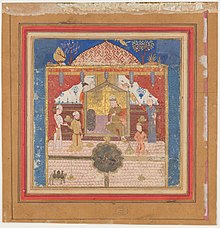
After Khosrow I,Hormizd IV(579–590) took the throne. The war with the Byzantines continued to rage intensely but inconclusively until the generalBahram Chobin,dismissed and humiliated by Hormizd, rose in revolt in 589. The following year, Hormizd was overthrown by a palace coup and his sonKhosrow II(590–628) placed on the throne. However, this change of ruler failed to placate Bahram, who defeated Khosrow, forcing him to flee to Byzantine territory, and seized the throne for himself as Bahram VI. Khosrow asked the Byzantine EmperorMaurice(582–602) for assistance against Bahram, offering to cede the western Caucasus to the Byzantines. To cement the alliance, Khosrow also married Maurice's daughter Miriam. Under the command of Khosrow and the Byzantine generalsNarsesandJohn Mystacon,the new combined Byzantine-Persian army raised a rebellion against Bahram, defeating him at theBattle of Blarathonin 591. When Khosrow was subsequently restored to power he kept his promise, handing over control of westernArmeniaandCaucasian Iberia.

The new peace arrangement allowed the two empires to focus on military matters elsewhere: Khosrow focused on the Sassanid Empire's eastern frontier while Maurice restored Byzantine control of theBalkans.Circa 600, theHephthaliteshad been raiding the Sassanid Empire as far asSpahanin central Iran. The Hephthalites issued numerous coins imitating the coinage of Khosrow II. Inc. 606/607,Khosrow recalledSmbat IV BagratunifromPersian Armeniaand sent him to Iran to repel the Hephthalites. Smbat, with the aid of a Persian prince named Datoyean, repelled the Hephthalites from Persia, and plundered their domains ineastern Khorasan,where Smbat is said to have killed their king in single combat.[79]
After Maurice was overthrown and killed byPhocas(602–610) in 602, however, Khosrow II used the murder of his benefactor as a pretext to begin a new invasion, which benefited from continuing civil war in the Byzantine Empire and met little effective resistance. Khosrow's generals systematically subdued the heavily fortified frontier cities of Byzantine Mesopotamia and Armenia, laying the foundations for unprecedented expansion. The Persians overranSyriaand captured Antioch in 611.
In 613, outside Antioch, the Persian generalsShahrbarazandShahindecisively defeated a major counter-attack led in person by the Byzantine emperorHeraclius.Thereafter, the Persian advance continued unchecked.Jerusalemfell in 614,Alexandriain 619, and the rest ofEgyptby 621. The Sassanid dream of restoring theAchaemenidboundaries was almost complete, while theByzantine Empirewas on the verge of collapse. This remarkable peak of expansion was paralleled by a blossoming ofPersian art,music,andarchitecture.
Decline and fall (622–651)
While successful at its first stage (from 602 to 622), the campaign ofKhosrau IIhad actually exhausted the Persian army and treasuries. In an effort to rebuild the national treasuries, Khosrau overtaxed the population. Thus, while his empire was on the verge of total defeat,Heraclius(610–641) drew on all his diminished and devastated empire's remaining resources, reorganised his armies, and mounted a remarkable, risky counter-offensive. Between 622 and 627, he campaigned against the Persians in Anatolia and the Caucasus, winning a string of victories against Persian forces underShahrbaraz,Shahin,andShahraplakan(whose competition to claim the glory of personally defeating the Byzantine emperor contributed to their failure), sacking the great Zoroastrian temple atGanzak,and securingassistancefrom theKhazarsandWestern Turkic Khaganate.

In response, Khosrau, in coordination withAvarandSlavicforces,launched a siegeon the Byzantine capital ofConstantinoplein 626. The Sassanids, led by Shahrbaraz, attacked the city on the eastern side of theBosphorus,while his Avar and Slavic allies invaded from the western side. Attempts to ferry the Persian forces across the Bosphorus to aid their allies (the Slavic forces being by far the most capable in siege warfare) were blocked by theByzantine fleet,and the siege ended in failure. In 627–628, Heraclius mounted a winter invasion of Mesopotamia, and, despite the departure of his Khazar allies, defeated a Persian army commanded byRhahzadhin theBattle of Nineveh.He then marched down the Tigris, devastating the country and sacking Khosrau's palace atDastagerd.He was prevented from attacking Ctesiphon by the destruction of the bridges on theNahrawan Canaland conducted further raids before withdrawing up theDiyalainto north-western Iran.[80]
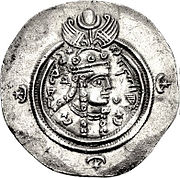
The impact of Heraclius's victories, the devastation of the richest territories of the Sassanid Empire, and the humiliating destruction of high-profile targets such as Ganzak and Dastagerd fatally undermined Khosrau's prestige and his support among the Persian aristocracy. In early 628, he was overthrown and murdered by his sonKavadh II(628), who immediately brought an end to the war, agreeing to withdraw from all occupied territories. In 629, Heraclius restored theTrue CrosstoJerusalemin a majestic ceremony.[80]Kavadh died within months, and chaos andcivil warfollowed. Over a period of four years and five successive kings, the Sassanid Empire weakened considerably. The power of the central authority passed into the hands of the generals. It would take several years for a strong king to emerge from a series of coups, and the Sassanids never had time to recover fully.[78]
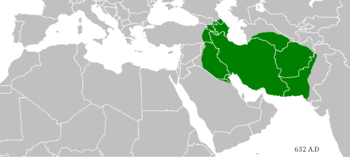
In early 632, a grandson of Khosrau I, who had lived in hiding inEstakhr,Yazdegerd III,acceded to the throne. The same year, the first raiders from theArabtribes, newly united byIslam,arrived in Persian territory. According to Howard-Johnston, years of warfare had exhausted both the Byzantines and the Persians. The Sassanids were further weakened by economic decline, heavy taxation, religious unrest, rigid social stratification, the increasing power of the provincial landholders, and a rapid turnover of rulers, facilitating theIslamic conquest of Persia.[81]
The Sassanids never mounted a truly effective resistance to the pressure applied by the initial Arab armies. Yazdegerd was a boy at the mercy of his advisers and incapable of uniting a vast country crumbling into small feudal kingdoms, despite the fact that the Byzantines, under similar pressure from the newly expansive Arabs, were no longer a threat. CaliphAbu Bakr's commanderKhalid ibn Walid,once one ofMuhammad's chosen companions-in-arms and leader of the Arab army, moved to captureIraqin a series of lightning battles. Redeployed to the Syrian front against the Byzantines in June 634, Khalid's successor in Iraq failed him, and the Muslims were defeated in theBattle of the Bridgein 634. However, the Arab threat did not stop there and reemerged shortly via the disciplined armies of Khalid ibn Walid.

In 637, a Muslim army under the CaliphUmar ibn al-Khattābdefeated a larger Persian force led by GeneralRostam Farrokhzadat the plains ofal-Qādisiyyah,and then advanced on Ctesiphon, which fell after a prolonged siege. Yazdegerd fled eastward from Ctesiphon, leaving behind him most of the empire's vast treasury. TheArabs captured Ctesiphonshortly afterward. Thus the Muslims were able to seize a powerful financial resource, leaving the Sassanid government strapped for funds. A number of Sassanid governors attempted to combine their forces to throw back the invaders, but the effort was crippled by the lack of a strong central authority, and the governors were defeated at theBattle of Nihawānd.The empire, with its military command structure non-existent, its non-noble troop levies decimated, its financial resources effectively destroyed, and theAsawaran (Azatan)knightly caste destroyed piecemeal, was now utterly helpless in the face of the Arab invaders.
Upon hearing of the defeat in Nihawānd, Yazdegerd along withFarrukhzadand some of the Persian nobles fled further inland to the eastern province ofKhorasan.Yazdegerd was assassinated by a miller inMervin late 651. His sons,PerozandBahram,fled toTang China.[82]Some of the nobles settled inCentral Asia,where they contributed greatly to spreading the Persian culture and language in those regions and to the establishment of the first native Iranian Islamic dynasty, theSamanid dynasty,which sought to revive Sassanid traditions.
The abrupt fall of the Sassanid Empire was completed in a period of just five years, and most of its territory was absorbed into the Islamiccaliphate;however, many Iranian cities resisted and fought against the invaders several times. Islamic caliphates repeatedly suppressed revolts in cities such asRey,Isfahan,andHamadan.[83]The local population was initially under little pressure to convert to Islam, remaining asdhimmisubjects of the Muslim state and paying ajizya.[84]In addition, the old Sassanid "land tax" (known in Arabic asKharaj) was also adopted. Caliph Umar is said to have occasionally set up a commission to survey the taxes, to judge if they were more than the land could bear.[85]
Descendants
It is believed that the following dynasties and noble families have ancestors among the Sassanian rulers:
- TheDabuyid dynasty(642–760) descendant ofJamasp.[86]
- ThePaduspanids(665–1598) ofMazandaran,descendant ofJamasp.[87]
- Theshahs of Shirwan(1100–1382) fromHormizd IV's line.[88]
- TheBanu Munajjim(9th–10th century) from Mihr Gushnasp, a Sasanian prince.
- TheKamkarian family(9th–10th century) adehqanfamily descended fromYazdegerd III.
- TheMikalids(9th–11th century) a family descended from the Sogdian rulerDivashtich,who was in turn a descendant ofBahram V.
Government
The Sassanids established an empire roughly within the frontiers achieved by the Parthian Arsacids, with the capital at Ctesiphon in theAsoristanprovince. In administering this empire, Sassanid rulers took the title ofshahanshah(King of Kings), becoming the central overlords and also assumed guardianship of thesacred fire,the symbol of the national religion. This symbol is explicit on Sassanid coins where the reigning monarch, with his crown and regalia of office, appears on the obverse, backed by the sacred fire, the symbol of the national religion, on the coin's reverse.[89]Sassanid queens had the title ofBanbishnan banbishn(Queen of Queens).
On a smaller scale, the territory might also be ruled by a number of petty rulers from a noble family, known asshahrdar,overseen directly by theshahanshah.The districts of the provinces were ruled by ashahraband amowbed(chief priest). The mowbed's job was to deal with estates and other things relating to legal matters.[90]Sasanian rule was characterized by considerable centralization, ambitious urban planning, agricultural development, and technological improvements.[78]Below the king, a powerful bureaucracy carried out much of the affairs of government; the head of the bureaucracy was thewuzurg framadar(vizierorprime minister). Within this bureaucracy the Zoroastrian priesthood was immensely powerful. The head of the Magi priestly class, themowbedan mowbed,along with the commander-in-chief, thespahbed,the head of traders and merchants syndicateHo Tokhshan Bodand minister of agriculture (wastaryoshan-salar), who was also head of farmers, were, below the emperor, the most powerful men of the Sassanid state.[91]
The Sassanian rulers always considered the advice of their ministers. A Muslim historian,Masudi,praised the "excellent administration of the Sasanian kings, their well-ordered policy, their care for their subjects, and the prosperity of their domains". In normal times, the monarchical office was hereditary, but might be transferred by the king to a younger son; in two instances the supreme power was held by queens. When no direct heir was available, the nobles and prelates chose a ruler, but their choice was restricted to members of the royal family.[92]
The Sasanian nobility was a mixture of old Parthian clans, Persian aristocratic families, and noble families from subjected territories. Many new noble families had risen after the dissolution of the Parthian dynasty, while several of the once-dominantSeven Parthian clansremained of high importance. At the court of Ardashir I, the old Arsacid families of theHouse of Karenand theHouse of Suren,along with several other families, the Varazes and Andigans, held positions of great honor. Alongside these Iranian and non-Iranian noble families, the kings ofMerv,Abarshahr,Kirman,Sakastan,Iberia,andAdiabene,who are mentioned as holding positions of honor amongst the nobles, appeared at the court of theshahanshah.Indeed, the extensive domains of the Surens, Karens and Varazes, had become part of the original Sassanid state as semi-independent states. Thus, the noble families that attended at the court of the Sassanid empire continued to be ruling lines in their own right, although subordinate to theshahanshah.
In general,Wuzurganfrom Iranian families held the most powerful positions in the imperial administration, including governorships of border provinces (marzban). Most of these positions were patrimonial, and many were passed down through a single family for generations. Themarzbansof greatest seniority were permitted a silver throne, whilemarzbansof the most strategic border provinces, such as theCaucasusprovince, were allowed a golden throne.[93]In military campaigns, the regionalmarzbanscould be regarded as field marshals, while lesserspahbedscould command a field army.[94]
Culturally, the Sassanids implemented a system of social stratification. This system was supported by Zoroastrianism, which was established as the state religion. Other religions appear to have been largely tolerated, although this claim has been debated.[95]Sassanid emperors consciously sought to resuscitatePersiantraditions and to obliterate Greek cultural influence.[78]
Sasanian military
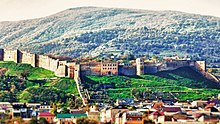
The active army of the Sassanid Empire originated fromArdashir I,the firstshahanshahof the empire. Ardashir restored the Achaemenid military organizations, retained theParthian cavalrymodel, and employed new types of armour andsiege warfaretechniques.
Role of priests
The relationship between priests and warriors was important, because the concept of Ērānshahr had been revived by the priests. Disagreements between the priests and the warriors led to fragmentation within the empire, which led to its downfall.[96]
Infantry

ThePayganformed the bulk of the Sassanid infantry, and were often recruited from the peasant population. Each unit was headed by an officer called a "Paygan-salar",which meant" commander of the infantry "and their main task was to guard the baggage train, serve as pages to theAsvaran(a higher rank), storm fortification walls, undertake entrenchment projects, and excavate mines.[97]
Those serving in the infantry were fitted with shields and lances. To make the size of their army larger, the Sassanids added soldiers provided by theMedesand theDailamitesto their own. The Medes provided the Sassanid army with high-quality javelin throwers, slingers and heavy infantry. Iranian infantry are described byAmmianus Marcellinusas "armed like gladiators" and "obey orders like so many horse-boys".[98]The Dailamite people also served as infantry and were Iranian people who lived mainly within Gilan, Iranian Azerbaijan and Mazandaran. They are reported as having fought with weapons such as daggers, swords and javelins and reputed to have been recognized by Romans for their skills and hardiness in close-quarter combat. One account of Dailamites recounted their participation in an invasion of Yemen where 800 of them were led by the Dailamite officerVahriz.[97]Vahriz would eventually defeat the Arab forces in Yemen and its capitalSana'amaking it a Sasanian vassal until the invasion of Persia by Arabs.[99]
Navy
TheSasanian navywas an important constituent of the Sasanian military from the time that Ardashir I conquered the Arab side of thePersian Gulf.Because controlling the Persian Gulf was an economic necessity, the Sasanian navy worked to keep it safe from piracy, prevent Roman encroachment, and keep the Arab tribes from getting hostile. However, it is believed by many historians that the naval force could not have been a strong one, as the men serving in the navy were those who were confined in prisons.[100]The leader of the navy bore the title ofnāvbed.[101]
Cavalry
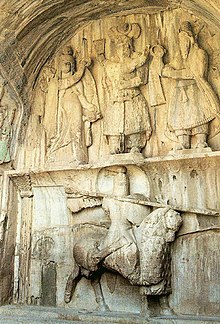

The cavalry used during the Sassanid Empire were two types of heavy cavalry units:ClibanariiandCataphracts.The first cavalry force, composed of elite noblemen trained since youth for military service, was supported by light cavalry, infantry and archers.[102]Mercenaries and tribal people of the empire, including the Turks, Kushans, Sarmatians, Khazars, Georgians, and Armenians were included in these first cavalry units. The second cavalry involved the use of thewar elephants.In fact, it was their specialty to deploy elephants as cavalry support.
Unlike the Parthians, the Sassanids developed advancedsiege engines.The development of siege weapons was a useful weapon during conflicts with Rome, in which success hinged upon the ability to seize cities and other fortified points; conversely, the Sassanids also developed a number of techniques for defending their own cities from attack. The Sassanid army was much like the preceding Parthian army, although some of the Sassanid's heavy cavalry were equipped with lances, while Parthian armies were heavily equipped with bows.[103]The Roman historianAmmianus Marcellinus's description of Shapur II's clibanarii cavalry manifestly shows how heavily equipped it was, and how only a portion were spear equipped:
All the companies were clad in iron, and all parts of their bodies were covered with thick plates, so fitted that the stiff-joints conformed with those of their limbs; and the forms of human faces were so skillfully fitted to their heads, that since their entire body was covered with metal, arrows that fell upon them could lodge only where they could see a little through tiny openings opposite the pupil of the eye, or where through the tip of their nose they were able to get a little breath. Of these, some who were armed with pikes, stood so motionless that you would have thought them held fast by clamps of bronze.
Horsemen in the Sassanid cavalry lacked a stirrup. Instead, they used a war saddle which had a cantle at the back and two guard clamps which curved across the top of the rider's thighs. This allowed the horsemen to stay in the saddle at all times during the battle, especially during violent encounters.[104]
The Byzantine emperor Maurikios also emphasizesin hisStrategikonthat many of the Sassanid heavy cavalry did not carry spears, relying on their bows as their primary weapons. Conversely the Taq-i Bustan reliefs and Al-Tabari's famed list of equipment required for dihqan knights included the lance.
The amount of money involved in maintaining a warrior of theAsawaran (Azatan)knightly caste required a small estate, and the Asawaran (Azatan) knightly caste received that from the throne, and in return, were the throne's most notable defenders in time of war.
Relations with neighboring regimes
Frequent warfare with the Romans and to a lesser extent others

The Sassanids, like the Parthians, were in constant hostilities with theRoman Empire.The Sassanids, who succeeded the Parthians, were recognized as one of the leading world powers alongside its neighboring rival the Byzantine Empire, or Eastern Roman Empire, for a period of more than 400 years.[14][15][16]Following the division of the Roman Empire in 395, the Byzantine Empire, with its capital atConstantinople,continued as Persia's principal western enemy, and main enemy in general. Hostilities between the two empires became more frequent.[78]The Sassanids, similar to the Roman Empire, were in a constant state of conflict with neighboring kingdoms and nomadic hordes. Although the threat of nomadic incursions could never be fully resolved, the Sassanids generally dealt much more successfully with these matters than did the Romans, due to their policy of making coordinated campaigns against threatening nomads.[105]
The last of the many and frequent wars with the Byzantines, the climacticByzantine–Sasanian War of 602–628,which included thesiege of the Byzantine capital Constantinople,ended with both rivalling sides having drastically exhausted their human and material resources. Furthermore,social conflict within the Empirehad considerably weakened it further.[106][107]Consequently, they were vulnerable to the sudden emergence of the IslamicRashidun Caliphate,whose forces invaded both empires only a few years after the war. TheMuslim forcesswiftlyconqueredtheentire Sasanian Empireand in theByzantine–Arab Warsdeprived the Byzantine Empire of itsterritories in the Levant,the Caucasus,Egypt,andNorth Africa.Over the following centuries, half the Byzantine Empire and the entire Sasanian Empire came under Muslim rule.
In general, over the span of the centuries, in the west, Sassanid territory abutted that of the large and stable Roman state, but to the east, its nearest neighbors were theKushan Empireand nomadic tribes such as theWhite Huns.The construction of fortifications such asTus citadelor the city ofNishapur,which later became a center of learning and trade, also assisted in defending the eastern provinces from attack.
In south and central Arabia,Bedouin Arabtribes occasionally raided the Sassanid empire. TheKingdom of Al-Hirah,a Sassanid vassal kingdom, was established to form a buffer zone between the empire's heartland and the Bedouin tribes. The dissolution of the Kingdom of Al-Hirah by Khosrau II in 602 contributed greatly to decisive Sassanid defeats suffered against Bedouin Arabs later in the century. These defeats resulted in a sudden takeover of the Sassanid empire by Bedouin tribes under the Islamic banner.

In the north,Khazarsand theWestern Turkic Khaganatefrequently assaulted the northern provinces of the empire. They plunderedMediain 634. Shortly thereafter, the Persian army defeated them and drove them out. The Sassanids built numerous fortifications in the Caucasus region to halt these attacks, such as the imposing fortifications built inDerbent(Dagestan,North Caucasus,now a part ofRussia) that to a large extent, have remained intact up to this day.
On the eastern side of the Caspian Sea, the Sassanians erected theGreat Wall of Gorgan,a 200 km-long defensive structure probably aimed to protect the empire from northern peoples, such as theWhite Huns.
War with Axum
In 522, before Khosrau's reign, a group of monophysiteAxumitesled an attack on the dominantHimyaritesof southern Arabia. The local Arab leader was able to resist the attack but appealed to the Sassanians for aid, while the Axumites subsequently turned towards the Byzantines for help. The Axumites sent another force across theRed Seaand this time successfully killed the Arab leader and replaced him with an Axumite man to be king of the region.[108]
In 531, Emperor Justinian suggested that the Axumites ofYemenshould cut out the Persians from Indian trade by maritime trade with the Indians. The Ethiopians never met this request because an Axumite general namedAbrahatook control of the Yemenite throne and created an independent nation.[108]After Abraha's death one of his sons, Ma'd-Karib, went into exile while his half-brother took the throne. After being denied by Justinian, Ma'd-Karib sought help from Khosrau, who sent a small fleet and army under commanderVahrizto depose the new king of Yemen. After capturing the capital city San'a'l, Ma'd-Karib's son, Saif, was put on the throne.[108]
Justinian was ultimately responsible for Sassanian maritime presence in Yemen. By not providing the Yemenite Arabs support, Khosrau was able to help Ma'd-Karib and subsequently established Yemen as a principality of the Sassanian Empire.[109]
Relations with China
Like their predecessors the Parthians, the Sassanid Empire carried out active foreign relations with China, and ambassadors from Persia frequently traveled to China. Chinese documents report on sixteen Sassanid embassies to China from 455 to 555.[110]Commercially, land and sea trade with China was important to both the Sassanid and Chinese Empires. Large numbers of Sassanid coins have been found in southern China, confirming maritime trade.
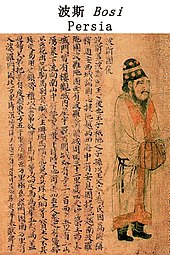
On different occasions, Sassanid kings sent their most talented Persian musicians and dancers to the Chinese imperial court atLuoyangduring theJinandNorthern Weidynasties, and toChang'anduring theSuiandTangdynasties. Both empires benefited from trade along theSilk Roadand shared a common interest in preserving and protecting that trade. They cooperated in guarding the trade routes through central Asia, and both built outposts in border areas to keep caravans safe from nomadic tribes and bandits.
Politically, there is evidence of several Sassanid and Chinese efforts in forging alliances against the common enemy, theHephthalites.Upon the rise of the nomadicGöktürksin Inner Asia, there is also what looks like a collaboration between China and the Sassanids to defuse Turkic advances. Documents from Mt. Mogh talk about the presence of a Chinese general in the service of the king ofSogdianaat the time of the Arab invasions.
Following the invasion of Iran by Muslim Arabs,Peroz III,son of Yazdegerd III, escaped along with a few Persian nobles and took refuge in the Chinese imperial court. Both Peroz and his sonNarsieh(Chineseneh-shie) were given high titles at the Chinese court. On at least two occasions, the last possibly in 670, Chinese troops were sent with Peroz in order to restore him to the Sassanid throne. Narsieh later attained the position of a commander of the Chinese imperial guards, and his descendants lived in China as respected princes, Sassanian refugees fleeing from the Arab conquest tosettle in China.The emperor of China at this time wasGaozong of Tang.
Relations with India

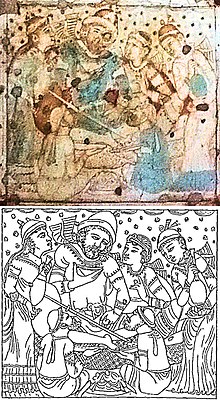
Following the conquest of Iran and neighboring regions,Shapur Iextended his authority northwest of theIndian subcontinent.The previously autonomousKushanswere obliged to accept his suzerainty.[112]These were the western Kushans which controlled Afghanistan[112]while the eastern Kushans were active in India. Although the Kushan empire declined at the end of the 3rd century, to be replaced by the IndianGupta Empirein the 4th century, it is clear that the Sassanids remained relevant in India's northwest throughout this period.[citation needed]
Persia and northwestern India, the latter that made up formerly part of the Kushans, engaged in cultural as well as political exchange during this period, as certain Sassanid practices spread into the Kushan territories. In particular, the Kushans were influenced by the Sassanid conception of kingship, which spread through the trade of Sassanid silverware and textiles depicting emperors hunting or dispensing justice.
This cultural interchange did not, however, spread Sassanid religious practices or attitudes to the Kushans. Lower-level cultural interchanges also took place between India and Persia during this period. For example, Persians imported the early form ofchess,thechaturanga(Middle Persian:chatrang) from India. In exchange, Persians introducedbackgammon(Nēw-Ardašēr) to India.
During Khosrau I's reign, many books were brought from India and translated intoMiddle Persian.Some of these later found their way into the literature of theIslamic worldandArabic literature.A notable example of this was the translation of the IndianPanchatantraby one of Khosrau's ministers,Borzuya.This translation, known as theKalīlag ud Dimnag,later made its way into the Arabic literature and Europe.[113]The details of Burzoe's legendary journey to India and his daring acquisition of the Panchatantra are written in full detail inFerdowsi'sShahnameh,which says:
In Indian books, Borzuya read that on a mountain in that land there grows a plant which when sprinkled over the dead revives them. Borzuya askedKhosrau Ifor permission to travel to India to obtain the plant. After a fruitless search, he was led to an ascetic who revealed the secret of the plant to him: The "plant" was word, the "mountain" learning, and the "dead" the ignorant. He told Borzuya of a book, the remedy of ignorance, called theKalila,which was kept in a treasure chamber. The king of India gave Borzuya permission to read the Kalila, provided that he did not make a copy of it. Borzuya accepted the condition but each day memorized a chapter of the book. When he returned to his room he would record what he had memorized that day, thus creating a copy of the book, which he sent to Iran. In Iran,Bozorgmehrtranslated the book intoPahlaviand, at Borzuya's request, named the first chapter after him.[114]
Society
Urbanism and nomadism

In contrast to Parthian society, the Sassanids renewed emphasis on acharismaticand centralized government. In Sassanid theory, the ideal society could maintain stability and justice, and the necessary instrument for this was a strong monarch.[115]Thus, the Sasanians aimed to be anurbanempire, at which they were quite successful. During the late Sasanian period, Mesopotamia had the largest population density in themedieval world.[116]This can be credited to, among other things, the Sasanians founding and re-founding a number of cities, which is talked about in the surviving Middle Persian textŠahrestānīhā ī Ērānšahr(the provincial capitals of Iran).[116]Ardashir I himself built and re-built many cities, which he named after himself, such asVeh-ArdashirinAsoristan,Ardashir-KhwarrahinParsandVahman-ArdashirinMeshan.During the Sasanian period, many cities with the name "Iran-khwarrah" were established. This was because Sasanians wanted to reviveAvestaideology.[116]
Many of these cities, both new and old, were populated not only by native ethnic groups, such as the Iranians or Syriacs, but also by thedeportedRoman prisoners of war, such asGoths,Slavs,Latins,and others.[116]Many of these prisoners were experienced workers, who were used to build things such as cities, bridges, and dams. This allowed the Sasanians to become familiar with Roman technology. The impact these foreigners made on the economy was significant, as many of them were Christians, and the spread of the religion accelerated throughout the empire.[116]
Unlike the amount of information about the settled people of the Sasanian Empire, there is little about the nomadic/unsettled ones. It is known that they were called "Kurds" by the Sasanians, and that they regularly served the Sasanian military, particularly theDailamiteandGilaninomads. This way of handling the nomads continued into the Islamic period, where the service of the Dailamites and Gilanis continued unabated.[117]
Shahanshah

The head of the Sasanian Empire was theshahanshah(king of kings), also simply known as theshah(king). His health and welfare was of high importance—accordingly, the phrase "May you be immortal" was used to reply to him. The Sasanian coins which appeared from the 6th-century and afterwards depict a moon and sun, which, in the words of the Iranian historianTouraj Daryaee,"suggest that the king was at the center of the world and the sun and moon revolved around him." In effect he was the "king of the four corners of the world", which was an old Mesopotamian idea.[118]The king saw all other rulers, such as the Romans, Turks, and Chinese, as being beneath him. The king wore colorful clothes, makeup, a heavy crown, while his beard was decorated with gold. The early Sasanian kings considered themselves of divine descent; they called themselves "bay" (divine).[119]
When the king went out in public, he was hidden behind a curtain,[118]and had some of his men in front of him, whose duty was to keep the masses away from him and to clear the way.[120]When one came to the king, one was expected to prostrate oneself before him, also known asproskynesis.The king's guards were known as thepushtigban.On other occasions, the king was protected by a discrete group of palace guards, known as thedarigan.Both of these groups were enlisted from royal families of the Sasanian Empire,[120]and were under the command of thehazarbed,who was in charge of the king's safety, controlled the entrance of the kings palace, presented visitors to the king, and was allowed military commands or used as a negotiator. Thehazarbedwas also allowed in some cases to serve as the royal executioner.[120]DuringNowruz(Iranian new year) andMihragan(Mihr's day), the king would hold a speech.[119]
Class division
Sassanid society was immensely complex, with separate systems of social organization governing numerous different groups within the empire.[121]Historians believe society comprised four[122][123][124]social classes:
- Asronan(priests)
- Arteshtaran(warriors)
- Wastaryoshan(commoners)
- Hutukhshan(artisans)
At the center of the Sasaniancastesystem theshahanshahruled over all the nobles.[125]The royal princes, petty rulers, great landlords and priests, together constituted a privileged stratum, and were identified aswuzurgan,or grandees. This social system appears to have been fairly rigid.[78]
The Sasanian caste system outlived the empire, continuing in the early Islamic period.[125]
Slavery
In general, mass slavery was never practiced by the Iranians, and in many cases the situation and lives of semi-slaves (prisoners of war) were, in fact, better than those of the commoner.[126]In Persia, the term "slave" was also used for debtors who had to use some of their time to serve in afire-temple.[127]
Some of the laws governing the ownership and treatment of slaves can be found in the legal compilation called theMatigan-i Hazar Datistan,a collection of rulings by Sasanian judges.[128]Principles that can be inferred from the laws include:
- Sources of slaves were both foreign (e.g., non-Zoroastrianscaptives from warfare or raiding or slaves imported from outside the Empire by traders) or domestic (e.g., hereditary slaves, children sold into slavery by their fathers, or criminals enslaved as punishment). Some cases suggest that a criminal's family might also be condemned to servitude. At the time of the manuscript's composition, Iranian slavery was hereditary on the mother's side (so that a child of a free man and a slave woman would be a slave), although the author reports that in earlier Persian history it may have been the opposite, being inherited from the father's side.
- Slave-owners had the right to the slaves' income.
- While slaves were formallychattel(property) and were liable to the same legal treatment as nonhuman property (for example, they could be sold at will, rented, owned jointly, inherited, given as security for a loan, etc.), Sasanian courts did not treat them completely as objects; for example, slaves were allowed to testify in court in cases concerning them, rather than only permitted to be represented by their owners.
- Slaves were often given to the Zoroastrianfire templesas a pious offering, in which case they and their descendants would become temple-slaves.
- Excessive cruelty towards slaves could result in the owners' being brought to court; a court case involving a slave whose owner tried to drown him in theTigris Riveris recorded, though without stating the outcome of the case.
- If a non-Zoroastrian slave, such as aChristianslave, converted toZoroastrianism,he or she could pay his or her price and attain freedom; i.e., as long as the owner was compensated,manumissionwas required.
- Owners could also voluntarily manumit their slaves, in which case the former slave became a subject of the Sasanian King of Kings and could not lawfully be re-enslaved later. Manumissions were recorded, which suggests that a freedman who was challenged would be able to document their free status.
- Uniquely in comparison to Western slave systems, Sasanian slavery recognized partial manumission (relevant in the case of a jointly owned slave, only some of whose owners were willing to manumit). In case of a slave who was, e.g., one-half manumitted, the slave would serve in alternating years.
To free a slave (irrespective of his or her faith) was considered a good deed.[129]Slaves had some rights including keeping gifts from the owner and at least three days of rest in the month.[129]
The most common slaves in the Sasanian Empire were the household servants, who worked in private estates and at the fire-temples. Usage of a woman slave in a home was common, and her master had outright control over her and could even produce children with her if he wanted to. Slaves also received wages and were able to have their own families whether they were female or male.[127]Harming a slave was considered a crime, and not even the king himself was allowed to do it.[130]
The master of a slave was allowed to free the person when he wanted to, which, no matter what faith the slave believed in, was considered a good deed.[130]A slave could also be freed if his/her master died.[127]
Culture
Education
There was a major school, called the Grand School, in the capital. In the beginning, only 50 students were allowed to study at the Grand School. In less than 100 years, enrollment at the Grand School was over 30,000 students.[131]
Society
On a lower level, Sasanian society was divided into Azatan (freemen). The Azatan formed a large low-aristocracy of low-level administrators, mostly living on small estates. The Azatan provided the cavalry backbone of theSasanian army.[121]
Arts, science, and literature
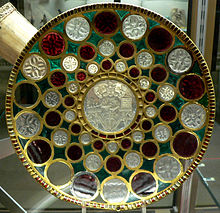
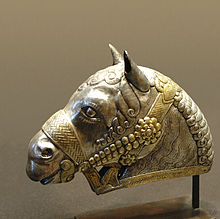


The Sasanian kings were patrons of letters and philosophy. Khosrau I had the works ofPlatoandAristotle,translated into Pahlavi, taught at Gundishapur, and read them himself. During his reign, many historical annals were compiled, of which the sole survivor is theKarnamak-i Artaxshir-i Papakan(Deeds of Ardashir), a mixture of history and romance that served as the basis of the Iranian national epic, theShahnameh.When Justinian I closed the schools ofAthens,seven of their professors went to Persia and found refuge at Khosrau's court. In his treaty of 533 with Justinian, the Sasanian king stipulated that the Greek sages should be allowed to return and be free from persecution.[92][page needed]
Under Khosrau I, theAcademy of Gundishapur,which had been founded in the 5th century, became "the greatest intellectual center of the time", drawing students and teachers from every quarter of the known world.Nestorian Christianswere received there, and broughtSyriactranslations of Greek works in medicine and philosophy. The medical lore of India, Persia, Syria and Greece mingled there to produce a flourishing school of therapy.[92][page needed]
Artistically, the Sasanian period witnessed some of the highest achievements ofIranian civilization.Much of what later became known as Muslim culture, including architecture and writing, was originally drawn from Persian culture. At its peak, the Sasanian Empire stretched from western Anatolia to northwest India (today Pakistan), but its influence was felt far beyond these political boundaries. Sasanian motifs found their way into the art ofCentral Asiaand China, theByzantine Empire,and evenMerovingianFrance.Islamic arthowever, was the true heir to Sasanian art, whose concepts it was to assimilate while at the same time instilling fresh life and renewed vigor into it.[22]According toWill Durant:
Sasanian art exported its forms and motifs eastward into India, Turkestan and China, westward into Syria, Asia Minor, Constantinople, the Balkans, Egypt and Spain. Probably its influence helped to change the emphasis in Greek art from classic representation to Byzantine ornament, and in Latin Christian art from wooden ceilings to brick or stone vaults and domes and buttressed walls.[92]
Sasanian carvings atTaq-e BostanandNaqsh-e Rustamwere colored; so were many features of the palaces; but only traces of such painting remain. The literature, however, makes it clear that the art of painting flourished in Sasanian times. Painting,sculpture,pottery,and other forms of decoration shared their designs with Sasanian textile art. Silks, embroideries,brocades,damasks,tapestries,chair covers, canopies, tents and rugs were woven with patience and masterly skill, and were dyed in warm tints of yellow, blue and green. Great colorful carpets had been an appendage of wealth in the East sinceAssyriandays. The two dozen Sasanian textiles that have survived are among the most highly valued fabrics in existence. Even in their own day, Sasanian textiles were admired and imitated from Egypt to the Far East; and during theMiddle Ages,they were favored for clothing the relics of Christian saints.
Studies on Sasanian remains show over 100 types of crowns being worn by Sasanian kings. The various Sasanian crowns demonstrate the cultural, economic, social and historical situation in each period. The crowns also show the character traits of each king in this era. Different symbols and signs on the crowns—the moon, stars, eagle and palm, each illustrate the wearer's religious faith and beliefs.[133][134]
The Sasanian dynasty, like the Achaemenid, originated in the province ofPars.The Sasanians saw themselves as successors of the Achaemenids, after theHellenisticand Parthian interlude, and believed that it was their destiny to restore the greatness of Persia.
In reviving the glories of theAchaemenidpast, the Sasanians were no mere imitators. The art of this period reveals an astonishing virility, in certain respects anticipating key features of Islamic art. Sasanian art combined elements of traditional Persian art with Hellenistic elements and influences. The conquest ofPersiabyAlexander the Greathad inaugurated the spread ofHellenistic artinto Western Asia. Though the East accepted the outward form of this art, it never really assimilated its spirit. Already in theParthianperiod, Hellenistic art was being interpreted freely by the peoples of the Near East. Throughout the Sasanian period, there was reaction against it. Sasanian art revived forms and traditions native to Persia, and in the Islamic period, these reached the shores of the Mediterranean.[135]According to Fergusson:
With the accession of the [Sasanians], Persia regained much of that power and stability to which she had been so long a stranger... The improvement in the fine arts at home indicates returning prosperity, and a degree of security unknown since the fall of the Achaemenidae.[136]
Surviving palaces illustrate the splendor in which the Sasanian monarchs lived. Examples include palaces atFiruzabadandBishapurinFars,and the capital city ofCtesiphonin theAsoristanprovince (present-dayIraq). In addition to local traditions, Parthian architecture influenced Sasanian architectural characteristics. All are characterized by the barrel-vaultediwansintroduced in the Parthian period. During the Sasanian period, these reached massive proportions, particularly at Ctesiphon. There, the arch of the great vaulted hall, attributed to the reign of Shapur I (241–272), has a span of more than 80 feet (24 m) and reaches a height of 118 feet (36 m). This magnificent structure fascinated architects in the centuries that followed and has been considered one of the most important examples ofPersian architecture.Many of the palaces contain an inner audience hall consisting, as at Firuzabad, of a chamber surmounted by a dome. The Persians solved the problem of constructing a circular dome on a square building by employingsquinches,or arches built across each corner of the square, thereby converting it into an octagon on which it is simple to place the dome. The dome chamber in the palace of Firuzabad is the earliest surviving example of the use of the squinch, suggesting that this architectural technique was probably invented in Persia.[citation needed]
The unique characteristic of Sasanian architecture was its distinctive use of space. The Sasanian architect conceived his building in terms of masses and surfaces; hence the use of massive walls of brick decorated with molded or carved stucco. Stucco wall decorations appear at Bishapur, but better examples are preserved fromChal TarkhannearRey(late Sasanian or early Islamic in date), and from Ctesiphon andKishin Mesopotamia. The panels show animal figures set in roundels, human busts, and geometric and floral motifs.[citation needed]
Economy
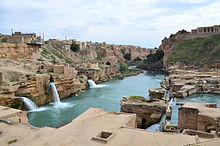

Due to the majority of the inhabitants being of peasant stock, the Sasanian economy relied on farming and agriculture, Khuzestan and Iraq being the most important provinces for it. TheNahravan Canalis one of the greatest examples of Sasanian irrigation systems, and many of these things can still be found in Iran. The mountains of the Sasanian state were used for lumbering by the nomads of the region, and the centralized nature of the Sasanian state allowed it to impose taxes on the nomads and inhabitants of the mountains. During the reign of Khosrau I, further land was brought under centralized administration.[137]
Two trade routes were used during the Sasanian period: one in the north, the famousSilk Route,and one less prominent route on the southern Sasanian coast. The factories ofSusa,Gundeshapur,andShushtarwere famously known for their production of silk, and rivaled the Chinese factories. The Sasanians showed great toleration to the inhabitants of the countryside, which allowed the latter to stockpile in case of famine.[137]
Industry and trade
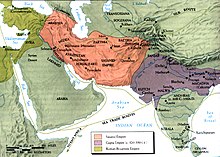
Persian industry under the Sasanians developed from domestic to urban forms. Guilds were numerous.Good roadsand bridges, well patrolled, enabled state post and merchant caravans to link Ctesiphon with all provinces; and harbors were built in the Persian Gulf to quicken trade with India.[92]Sasanian merchants ranged far and wide and gradually ousted Romans from the lucrative Indian Ocean trade routes.[138]Recent archeological discovery has shown the interesting fact that Sasanians used special labels (commercial labels) on goods as a way of promoting their brands and distinguish between different qualities.[139]
Khosrau I further extended the already vast trade network. The Sasanian state now tended toward monopolistic control of trade, with luxury goods assuming a far greater role in the trade than heretofore, and the great activity in building of ports, caravanserais, bridges and the like, was linked to trade and urbanization. The Persians dominated international trade, both in theIndian Ocean,Central Asia and South Russia, in the time of Khosrau, although competition with the Byzantines was at times intense. Sassanian settlements inOmanandYementestify to the importance of trade with India, but the silk trade with China was mainly in the hands of Sasanian vassals and the Iranian people, theSogdians.[140]
The main exports of the Sasanians were silk; woolen and golden textiles; carpets and rugs; hides; and leather and pearls from thePersian Gulf.There were also goods in transit from China (paper, silk) and India (spices), which Sasanian customs imposed taxes upon, and which were re-exported from the Empire to Europe.[141]
It was also a time of increased metallurgical production, so Iran earned a reputation as the "armory of Asia". Most of the Sasanian mining centers were at the fringes of the Empire – in Armenia, the Caucasus and above all,Transoxania.The extraordinary mineral wealth of thePamir Mountainsled to a legend among theTajiks:when God was creating the world, he tripped over the Pamirs, dropping his jar of minerals, which spread across the region.[138]
Religion
Zoroastrianism
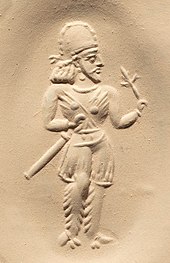
UnderParthian rule,Zoroastrianism had fragmented into regional variations which also saw the rise of local cult-deities, some from Iranian religious tradition but others drawn fromGreektradition too. Greek paganism and religious ideas had spread and mixed with Zoroastrianism whenAlexander the Greathad conquered thePersian EmpirefromDarius III—a process of Greco-Persian religious and cultural synthesisation which had continued into the Parthian era. However, under the Sassanids, an orthodox Zoroastrianism was revived and the religion would undergo numerous and important developments.
Sassanid Zoroastrianism developed clear distinctions from the practices laid out in theAvesta,the holy books of Zoroastrianism. Sassanid religious policies contributed to the flourishing of numerous religious reform movements, most importantly those founded by the religious leadersManiandMazdak.[citation needed]
The relationship between the Sassanid kings and the religions practiced in their empire became complex and varied. For instance, whileShapur Itolerated and encouraged a variety of religions and seems to have been aZurvanitehimself, religious minorities at times were suppressed under later kings, such asBahram II.Shapur II, on the other hand, tolerated religious groups except Christians, whom he only persecuted in the wake of Constantine's conversion.[143][144]
Tansar and his justification for Ardashir I's rebellion
From the very beginning of Sassanid rule in 224, an orthodoxPars-oriented Zoroastrian tradition would play an important part in influencing and lending legitimization to the state until its collapse in the mid-7th century. AfterArdashir Ihad deposed the lastParthianKing,Artabanus IV,he sought the aid ofTansar,aherbad(high priest) of the Iranian Zoroastrians to aid him in acquiring legitimization for the new dynasty. This Tansar did by writing to the nominal and vassal kings in different regions ofIranto accept Ardashir I as their new King, most notably in theLetter of Tansar,which was addressed toGushnasp,the vassal king ofTabarestan.Gushnasp had accused Ardashir I of having forsaken tradition by usurping the throne, and that while his actions "may have been good for the World" they were "bad for the faith". Tansar refuted these charges in his letter to Gushnasp by proclaiming that not all of the old ways had been good, and that Ardashir was more virtuous than his predecessors. TheLetter of Tansarincluded some attacks on the religious practices and orientation of the Parthians, who did not follow an orthodox Zoroastrian tradition but rather a heterodox one, and so attempted to justify Ardashir's rebellion against them by arguing that Zoroastrianism had 'decayed' after Alexander's invasion, a decay which had continued under the Parthians and so needed to be 'restored'.[145]
Tansarwould later help to oversee the formation of a single 'Zoroastrian church' under the control of the Persianmagi,alongside the establishment of a single set ofAvestantexts, which he himself approved and authorised.
Influence of Kartir
Kartir,a very powerful and influential Persian cleric, served under several Sassanid Kings and actively campaigned for the establishment of aPars-centred Zoroastrian orthodoxy across the Sassanid Empire. His power and influence grew so much that he became the only 'commoner' to later be allowed to have his own rock inscriptions carved in the royal fashion (atSar Mashhad,Naqsh-e Rostam,Ka'ba-ye ZartoshtandNaqsh-e Rajab). UnderShapur I,Kartir was made the 'absolute authority' over the 'order of priests' at the Sassanid court and throughout the empire's regions too, with the implication that all regional Zoroastrian clergies would now for the first time be subordinated to the Persian Zoroastrian clerics ofPars.To some extent Kartir was aniconoclastand took it upon himself to help establish numerous Bahram fires throughout Iran in the place of the 'bagins / ayazans' (monuments and temples containing images and idols of cult-deities) that had proliferated during the Parthian era. In expressing his doctrinal orthodoxy, Kartir also encouraged an obscure Zoroastrian concept known askhvedodahamong the common-folk (marriage within the family; between siblings, cousins). At various stages during his long career at court, Kartir also oversaw the periodic persecution of the non-Zoroastrians in Iran, and secured the execution of the prophetManiduring the reign ofBahram I.During the reign ofHormizd I(the predecessor and brother of Bahram I) Kartir was awarded the new Zoroastrian title ofmobad—a clerical title that was to be considered higher than that of the eastern-Iranian (Parthian) title ofherbad.[145]
Zoroastrian calendar reforms under the Sasanians
The Persians had long known of the Egyptian calendar, with its 365 days divided into 12 months. However, the traditional Zoroastrian calendar had 12 months of 30 days each. During the reign ofArdashir I,an effort was made to introduce a more accurate Zoroastrian calendar for the year, so 5 extra days were added to it. These 5 extra days were named theGatha daysand had a practical as well as religious use. However, they were still kept apart from the 'religious year', so as not to disturb the long-held observances of the older Zoroastrian calendar.
Some difficulties arose with the introduction of the first calendar reform, particularly the pushing forward of important Zoroastrian festivals such as Hamaspat-maedaya andNowruzon the calendar year by year. This confusion apparently caused much distress among ordinary people, and while the Sassanids tried to enforce the observance of these great celebrations on the new official dates, much of the populace continued to observe them on the older, traditional dates, and so parallel celebrations for Nowruz and other Zoroastrian celebrations would often occur within days of each other, in defiance of the new official calendar dates, causing much confusion and friction between the laity and the ruling class. A compromise on this by the Sassanids was later introduced, by linking the parallel celebrations as a 6-day celebration/feast. This was done for all except Nowruz.
A further problem occurred as Nowruz had shifted in position during this period from thespring equinoxtoautumn,although this inconsistency with the original spring-equinox date for Nowruz had possibly occurred during the Parthian period too.
Further calendar reforms occurred during the later Sassanid era. Ever since the reforms underArdashir Ithere had been no intercalation. Thus with a quarter-day being lost each year, the Zoroastrian holy year had slowly slipped backwards, with Nowruz eventually ending up in July. A great council was therefore convened and it was decided that Nowruz be moved back to the original position it had during theAchaemenidperiod—back tospring.This change probably took place during the reign ofKavad Iin the early 6th century. Much emphasis seems to have been placed during this period on the importance of spring and on its connection with the resurrection andFrashegerd.[145]
Three Great Fires

Reflecting the regional rivalry and bias the Sassanids are believed to have held against theirParthianpredecessors, it was probably during the Sassanid era that the two great fires inParsandMedia—theAdur FarnbagandAdur Gushnasprespectively—were promoted to rival, and even eclipse, the sacred fire inParthia,theAdur Burzen-Mehr.The Adur Burzen-Mehr, linked (in legend) withZoroasterandVishtaspa(the first Zoroastrian King), was too holy for the Persian magi to end veneration of it completely.
It was therefore during the Sassanid era that the threeGreat Firesof the Zoroastrian world were given specific associations. TheAdur Farnbagin Pars became associated with themagi,Adur Gushnaspin Media with warriors, andAdur Burzen-Mehrin Parthia with the lowest estate, farmers and herdsmen.
TheAdur Gushnaspeventually became, by custom, a place of pilgrimage by foot for newly enthroned Kings after their coronation. It is likely that, during the Sassanid era, these threeGreat Firesbecame central places for pilgrimage among Zoroastrians.[145]
Iconoclasm and the elevation of Persian over other Iranian languages
The early Sassanids ruled against the use of cult images in worship, and so statues and idols were removed from many temples and, where possible, sacred fires were installed instead. This policy extended even to the'non-Iran'regions of the empire during some periods. Hormizd I allegedly destroyed statues erected for the dead inArmenia.However, only cult-statues were removed. The Sassanids continued to use images to represent the deities of Zoroastrianism, including that ofAhura Mazda,in the tradition that was established during theSeleucidera.
In the early Sassanid period royal inscriptions often consisted ofParthian,Middle PersianandGreek.However, the last time Parthian was used for a royal inscription came during the reign ofNarseh,son ofShapur I.It is likely therefore that soon after this, the Sassanids made the decision to impose Persian as the sole official language within Iran, and forbade the use of written Parthian. This had important consequences for Zoroastrianism, given that all secondary literature, including theZand,was then recorded only inMiddle Persian,having a profound impact in orienting Zoroastrianism towards the influence of theParsregion, the homeland of the Sassanids.[145]
Developments in Zoroastrian literature and liturgy by the Sasanians
Some scholars of Zoroastrianism such asMary Boycehave speculated that it is possible that theyasnaservice was lengthened during the Sassanid era "to increase its impressiveness".[146]This appears to have been done by joining theGathicStaota Yesnyawith thehaomaceremony. Furthermore, it is believed that another longer service developed, known as theVisperad,which derived from the extended yasna. This was developed for the celebration of the seven holy days of obligation (theGahambarsplusNowruz) and was dedicated toAhura Mazda.
While the very earliest Zoroastrians eschewed writing as a form of demonic practice, theMiddle PersianZand,along with much secondary Zoroastrian literature, was recorded in writing during the Sassanid era for the first time. Many of these Zoroastrian texts were original works from the Sassanid period. Perhaps the most important of these works was theBundahishn—the mythical Zoroastrian story of Creation. Other older works, some from remote antiquity, were possibly translated from different Iranian languages into Middle Persian during this period. For example, two works, theDrakht-i Asurig(Assyrian Tree) andAyadgar-i Zareran(Exploits of Zarter) were probably translated fromParthianoriginals.

Of great importance for Zoroastrianism was the creation of theAvestan Alpha betby the Sassanids, which enabled the accurate rendering of theAvestain written form (including in its original language/phonology) for the first time. The Alpha bet was based on thePahlavione, but rather than the inadequacy of that script for recording spoken Middle Persian, the Avestan Alpha bet had 46 letters, and was well suited to recordingAvestanin written form in the way the language actually sounded and was uttered. The Persianmagiwere therefore finally able to record all surviving ancient Avestan texts in written form. As a result of this development, the Sasanian Avesta was then compiled into 21 nasks (divisions) to correspond with the 21 words of theAhunavarinvocation.
An important literary text, theKhwaday-Namag(Book of Kings), was composed during the Sasanian era. This text is the basis of the laterShahnamehofFerdowsi.Another important Zoroastrian text from the Sasanian period includes theDadestan-e Menog-e Khrad(Judgments of the Spirit of Wisdom).[145]
Christianity
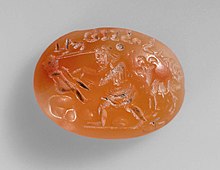
Christians in the Sasanian Empire belonged mainly to theNestorian Church(Church of the East) and theJacobite Church(Syriac Orthodox Church). Although these churches originally maintained ties with Christian churches in the Roman Empire, they were quite different from them: theliturgical languageof the Nestorian and Jacobite Churches wasSyriacrather than Greek. Another reason for a separation between Eastern and Western Christianity was strong pressure from the Sasanian authorities to sever connections with Rome, since the Sasanian Empire was often at war with the Roman Empire.
Christianity was recognized by Yazdegerd I in 409 as an allowable faith within the Sasanian Empire.[147]
The major break with mainstream Christianity came in 431, due to the pronouncements of theFirst Council of Ephesus.The Council condemnedNestorius,thepatriarch of Constantinople,for teaching a view ofChristologyin accordance with which he refused to callMary, mother of Jesus,"Theotokos"or Mother of God. While the teaching of the Council of Ephesus was accepted within the Roman Empire, the Sasanian church disagreed with the condemnation of Nestorius' teachings. When Nestorius was deposed as patriarch, a number of his followers fled to the Sasanian Empire. Persian emperors used this opportunity to strengthen Nestorius' position within the Sasanian church (which made up the vast majority of the Christians in the predominantly Zoroastrian Persian Empire) by eliminating the most important pro-Roman clergymen in Persia and making sure that their places were taken by Nestorians. This was to assure that these Christians would be loyal to the Persian Empire, and not to the Roman.[citation needed]
Most of the Christians in the Sasanian empire lived on the western edge of the empire, predominantly in Mesopotamia, but there were also important extant communities in the more northern territories, namelyCaucasian Albania,Lazica,Iberia,and the Persian part of Armenia. Other important communities were to be found on the island ofTylos(present dayBahrain), the southern coast of the Persian Gulf, and the area of theArabiankingdom ofLakhm.Some of these areas were the earliest to be Christianized; the kingdom ofArmeniabecame the first independent Christian state in the world in 301. While a number of Assyrian territories had almost become fully Christianized even earlier during the 3rd century, they never became independent nations.[73]
Other religions
Some of the recent excavations have discovered theBuddhist,Hinduand Jewish religious sites in the empire.[148]Buddhismwere competitors of Zoroastrianism inBactriaandMargiana,[149]in the far easternmost territories. A very large Jewish community flourished under Sasanian rule, with thriving centers atIsfahan,BabylonandKhorasan,and with its own semiautonomousExilarchateleadership based in Mesopotamia. Jewish communities suffered only occasional persecution. They enjoyed a relative freedom of religion, and were granted privileges denied to other religious minorities.[150]Shapur I (Shabur Malka in Aramaic) was a particular friend to the Jews. His friendship withShmuelproduced many advantages for the Jewish community.[151]
Language
Official languages
During the early Sasanian period,Middle Persianalong withKoine GreekandParthianappeared in the inscriptions of the early Sasanian kings. However, by the time Narseh (r. 293–302) was ruling, Greek was no longer in use, perhaps due to the disappearance of Greek or the efforts of the anti-Hellenic Zoroastrian clergy to remove it once and for all. This was probably also because Greek was commonplace among the Romans/Byzantines, the rivals of the Sasanians.[2]Parthian soon disappeared as an administrative language too, but was continued to be spoken and written in the eastern part of the Sasanian Empire, the homeland of the Parthians.[152]Furthermore, many of the Parthian aristocrats who had entered into Sasanian service after the fall of theParthian Empirestill spoke Parthian, such as the seven Parthian clans, who possessed much power within the empire. Sometimes one of the members of the clans would even protest against Sasanian rule.[citation needed]The Sasanian Empire appears to have stopped using the Parthian language in their official inscriptions during the reign ofNarseh.[153]
Aramaic,like in theAchaemenid Empire,was widely used in the Sasanian Empire (from Antioch to Mesopotamia), although Imperial Aramaic began to be replaced by Middle Persian as the administrative language.[154]
Regional languages
Although Middle Persian was the native language of the Sasanians (who, however, were not originally fromPars), it was only a minority spoken-language in the vast Sasanian Empire; it only formed the majority of Pars, while it was widespread aroundMediaand its surrounding regions. However, there were several different Persian dialects during that time. Besides Persian, the unattested predecessor ofAdharialong with one of its dialects, Tati, was spoken inAdurbadagan(Azerbaijan). UnwrittenPre-Daylamiteand probablyProto-Caspian,which later becameGilakiinGilanandMazandarani(also known as Tabari) inTabaristan,were spoken about in the same regions. Furthermore, some other languages and dialects were spoken in the two regions.[155]
In the Sasanian territories in the Caucasus, numerous languages were spoken includingOld Georgian,variousKartvelian languages(notably in Lazica), Middle Persian,[156]Old Armenian,Caucasian Albanian,Scythian,Koine Greek, and others.
InKhuzestan,several languages were spoken; Persian in the north and east, whileEastern Middle Aramaicwas spoken in the rest of the place.[157]Furthermore, lateNeo-Elamitemay also have been spoken in the province[155]but there are no references explicitly naming the language. InMeshan,Strabodivided theSemiticpopulation of the province into "Chaldeans" (Aramaic-speakers) and "Mesenian Arabs". Nomadic Arabs along withNabataeanandPalmyrenemerchants are believed to have added to the population as well. Iranians had also begun to settle in the province, along with theZutt,who had been deported fromIndia.Other Indian groups such as theMalaysmay also have been deported to Meshan, either as captives or recruited sailors.[158]InAsoristan,the majority of the people were Aramaic-speaking Nestorian Christians, notably includingMiddle Syriac,while the Persians, Jews and Arabs formed a minority in the province.
Due to invasions from theScythiansand their sub-group, theAlans,into Atropatene, Armenia, and other places in the Caucasus, the places gained a larger, although small, Iranian population.[159]Parthian was spoken inKhorasanalong with other Iranian dialects and languages, while theSogdian,BactrianandKhwarazmianlanguages were spoken further east in places which were not always controlled by the Sasanians. To the further south inSakastan,which saw an influx ofScythiansduring the Parthian period, much later the place ofSistanian Persian,[160][155]an unknownMiddle Southwestern Iranian languagewas spoken if it was not likely Middle Persian as well.Kirmanwas populated by an Iranian group which closely resembled the Persians while, farther to the east inParatan,TuranandMakran,non-Iranian languages[160]and an unknownMiddle Northwestern Iranian languagewere spoken. In major cities such asGundeshapurand Ctesiphon,Latin,Greek and Syriac were spoken by Roman/Byzantine prisoners of war. Furthermore,SlavicandGermanicwere also spoken in the Sasanian Empire, once again due to the capture of Roman soldiers[161]but this must have been negligible. Semitic languages includingHimyariticandSabaeanwere spoken inYemen.
Legacy and importance
The influence of the Sasanian Empire continued long after it fell. The empire had achieved aPersian renaissancethat would become a driving force behind thecivilizationof the newly established religion ofIslam.[162]In modernIranand the regions of theIranosphere,the Sasanian period is regarded as one of the high points ofIranian civilization.[163]
In Europe

Sasanian culture and military structure had a significant influence onRoman civilization.The structure and character of theRoman armywas affected by the methods of Persian warfare. In a modified form, the Roman Imperial autocracy imitated the royal ceremonies of the Sasanian court at Ctesiphon, and those in turn had an influence on the ceremonial traditions of thecourtsof medieval and modern Europe. The origin of the formalities of European diplomacy is attributed to the diplomatic relations between the Persian governments and the Roman Empire.[164]
In Jewish history
Important developments inJewish historyare associated with the Sassanian Empire. The BabylonianTalmudwas composed between the third and sixth centuries in Sasanian Persia[165]and major Jewish academies of learning were established inSuraandPumbeditathat became cornerstones ofJewish scholarship.[166]Several individuals of the Imperial family such as Ifra Hormizd the Queen mother of Shapur II and QueenShushandukht,the Jewish wife of Yazdegerd I, significantly contributed to the close relations between the Jews of the empire and the government in Ctesiphon.[167]
In India

The collapse of the Sasanian Empire led to Islam slowly replacing Zoroastrianism as the primary religion of Iran. A large number of Zoroastrians chose to emigrate to escape Islamic persecution. According to theQissa-i Sanjan,one group of those refugees landed in what is nowGujarat,India, where they were allowed greater freedom to observe their customs and preserve their faith. The descendants of those Zoroastrians would play a small but significant role in the development of India. Today there are over 70,000 Zoroastrians in India.[168]
The Zoroastrians still use a variant of the religious calendar instituted under the Sasanians. That calendar still marks the number of years since the accession of Yazdegerd III.[d]
Chronology

- 224–241: Reign ofArdashir I:
- 224: Overthrow of theParthian Empire
- 229–232: War with Rome
- Zoroastrianismis revived as official religion
- The collection of texts known as the ZendAvestais assembled
- 241–271: Reign ofShapur I"the Great":
- 241–244: War with Rome
- 252–261: War with Rome. Decisive victory of Persian atEdessaand Capture of Roman emperorValerian
- 215–271:Mani,founder ofManichaeism
- 271–301: A period of dynastic struggles.
- 283: War with Rome.
- 293: Revolt ofNarseh.
- 296–298: War with Rome – Persia cedes five provinces east of the Tigris to Rome.
- 309–379: Reign ofShapur II"the Great":
- 387: Armenia partitioned into Roman and Persian zones
- 399–420: Reign ofYazdegerd I"the Sinner":
- 410:Church of the Eastformalised at thesynod of Isaacunder the patronage of Yazdegerd. Christians are permitted to publicly worship and to build churches
- 416–420: Persecution of Christians as Yazdegerd revokes his earlier order
- 420–438: Reign ofBahram V:
- 421–422: War with Rome
- 424: Council of Dad-Ishu declares the Eastern Church independent of Constantinople
- 428: Persian zone of Armenia annexed to Sasanian Empire
- 438–457: Reign ofYazdegerd II:
- 440: War with the Byzantine Empire; the Romans give some payments to the Sasanians[171]
- 449–451: Armenian revolt.Battle of Avarayrfought in 451 against the ChristianArmenianrebels led byVardan Mamikonian.
- 482–483: Armenian and Iberian revolt
- 483: Edict of Toleration granted to Christians
- 484:Peroz Idefeated and killed by Hephthalites. TheTreaty of Nvarsakgrants theArmeniansthe right to profess Christianity freely.
- 491: Armenian revolt. Armenian Church repudiates theCouncil of Chalcedon;Nestorian Christianitybecomes dominant Christian sect in Sasanian Empire
- 502–506: War with theByzantine Empire.In the end theByzantine Empirepays 1,000 pounds of gold to the Sasanian Empire[67]The Sasanians captureTheodosiopolisandMartyropolis.
Byzantine EmpirereceivedAmidafor 1,000 pounds of gold.[67] - 526–532: War with theByzantine Empire.Treaty ofEternal Peace:The Sasanian Empire keepsIberiaand theByzantine Empirereceives Lazica and Persarmenia;[172]theByzantine Empirepays tribute 11,000 lbs gold/year.[172]
- 531–579: Reign ofKhosrow I,"with the immortal soul" (Anushirvan).
- 541–562: War with theByzantine Empire.
- 572–591: War with theByzantine Empire.
- 580: The Sasanians underHormizd IVabolish the monarchy of theKingdom of Iberia.Direct control throughSasanian-appointed governorsstarts.
- 590:Rebellion of Bahram Chobinand other Sasanian nobles,Khosrow IIoverthrowsHormizd IVbut loses the throne toBahram Chobin.
- 591:Khosrow IIregains the throne with help from theByzantine Empireand cedes Persian Armenia and the western half of Iberia to theByzantine Empire.
- 593: Attempted usurpation ofHormizd V
- 595–602: Rebellion ofVistahm
- 603–628: War with theByzantine Empire.Persia occupies Byzantine Mesopotamia, Anatolia, Syria, Palestine, Egypt and the Transcaucasus, before being driven to withdraw to pre-war frontiers by Byzantine counter-offensive
- 610: Arabs defeat a Sasanian army atDhu-Qar
- 626: Unsuccessful siege ofConstantinopleby Avars, Persians, and Slavs.
- 627: Byzantine EmperorHeracliusinvades Sasanian Mesopotamia. Decisive defeat of Persian forces at thebattle of Nineveh
- 628:Kavad IIoverthrowsKhosrow IIand becomes Shahanshah.
- 628: A devastating plague kills half of the population in Western Persia, includingKavad II.[67]
- 628–632:Civil war
- 632–644: Reign ofYazdegerd III
- 636: Decisive Sasanian defeat at theBattle of al-Qādisiyyahduring theMuslim conquest of Persia
- 641: TheMuslimsdefeat a massiveSasanian armywith heavy casualties during theBattle of Nihawānd
- 644: TheMuslimsconquerKhorasan;Yazdegerd III becomes a hunted fugitive
- 651:Yazdegerd IIIflees eastward from one district to another, until at last he is killed by a local miller for his purse atMerv(present-dayTurkmenistan), ending the dynasty. Yazdegerd is given a burial by the Assyrian bishop Mar Gregory.[173]His son,Peroz III,and many others go into exile in China.[174]
See also
- List of Sasanian revolts and civil wars
- List of Zoroastrian states and dynasties
- Military of the Sasanian Empire
- Romans in Persia
- Sasanian art
- Sasanian family tree
- Sasanian music
- Women in the Sasanian Empire
Notes
- ^Book Pahlavispelling:
 (ʾylʾnštr');Inscriptional Pahlavispelling:𐭠𐭩𐭥𐭠𐭭𐭱𐭲𐭥𐭩(ʾyrʾnštry),𐭠𐭩𐭫𐭠𐭭𐭱𐭲𐭥𐭩(ʾylʾnštry);Modern Persian:ایرانشهرwhence theNew PersiantermsIranshahrandIran[11]
(ʾylʾnštr');Inscriptional Pahlavispelling:𐭠𐭩𐭥𐭠𐭭𐭱𐭲𐭥𐭩(ʾyrʾnštry),𐭠𐭩𐭫𐭠𐭭𐭱𐭲𐭥𐭩(ʾylʾnštry);Modern Persian:ایرانشهرwhence theNew PersiantermsIranshahrandIran[11]
- ^Middle Persian:ērānšahr xwadāy hēm,Parthian:aryānšahr xwadāy ahēm,Greek:egō... tou Arianōn ethnous despotēs eimi
- ^See also:Raba
- ^See also:Zoroastrian calendar
References
- ^"Ctesiphon – Encyclopaedia Iranica".Iranicaonline.org.Retrieved16 December2013.
- ^abDaryaee 2008,pp. 99–100.
- ^First Encyclopaedia of Islam: 1913–1936.Brill. 1993. p. 179.
- ^Pourshariati 2008,p. 4.
- ^Turchin, Peter; Adams, Jonathan M.; Hall, Thomas D (December 2006)."East-West Orientation of Historical Empires".Journal of World-Systems Research.12(2): 223.ISSN1076-156X.Retrieved11 September2016.
- ^Taagepera, Rein (1979). "Size and Duration of Empires: Growth-Decline Curves, 600 B.C. to 600 A.D.".Social Science History.3(3/4). p. 122.doi:10.2307/1170959.JSTOR1170959.
- ^Mayson Kirby (2018).History of Civilizations.p. 119.
Control of Southwest Asia passed from the Seleucids to the Parthian Empire, then to the Second Persian Empire (aka Sassanid Empire).
- ^Michael W. Ford (2014).Drauga - Ahrimanian Yatuk Dinoih.p. 43.
The second Persian Empire began with Ardashir I, son of Papak, a descendant of the priests of Anahita in Istakhr in Fars.
- ^Canepa 2018,p. 9.
- ^Daryaee 2018,p. 1.
- ^MacKenzie, D. N. (2005),A Concise Pahlavi Dictionary,London & New York: Routledge Curzon, p. 120,ISBN978-0-19-713559-4
- ^(Wiesehöfer 1996)
- ^"A Brief History".Culture of Iran.Archived fromthe originalon 21 November 2001.Retrieved11 September2009.
- ^ab(Shahbazi 2005)
- ^abNorman A. StillmanThe Jews of Arab Landsp. 22 Jewish Publication Society, 1979ISBN0827611552
- ^abInternational Congress of Byzantine StudiesProceedings of the 21st International Congress of Byzantine Studies, London, 21–26 August 2006, Volumes 1–3p. 29. Ashgate Pub Co, 2006ISBN075465740X
- ^Hourani, p. 87.
- ^Eiland, Murray (2004)."West Asia 300 BC–AD 600".In Onians, John (ed.).Atlas of World Art.Oxford University Press. pp. 80–81.ISBN978-0195215830.
- ^Durant, Will(1950).The Age of Faith.p. 150.
Repaying its debt, Sasanian art exported its forms and motives eastward into India, Turkestan, and China, westward into Syria, Asia Minor, Constantinople, the Balkans, Egypt, and Spain.
- ^"Transoxiana 04: Sasanians in Africa".Transoxiana.ar.Retrieved16 December2013.
- ^Sarfaraz, pp. 329–330
- ^ab"Iransaga: The art of Sassanians".Artarena.force9.co.uk.Retrieved16 December2013.
- ^Abdolhossein Zarinkoob:Ruzgaran: tarikh-i Iran az aghz ta saqut saltnat Pahlvi,p. 305
- ^"Ērān, Ērānšahr – Encyclopaedia Iranica".iranicaonline.org.Retrieved9 November2019.
- ^Fattah, Hala Mundhir (2009).A Brief History of Iraq.Infobase Publishing.p.49.ISBN978-0-8160-5767-2.
Historians have also referred to the Sassanian Empire as the Neo-Persian Empire.
- ^Frye 2005,p. 461
- ^Farrokh 2007,p. 178
- ^Zarinkoob 1999,pp. 194, 198
- ^Farrokh 2007,p. 180
- ^Frye 2005,pp. 465–466
- ^Frye 2005,pp. 466–467
- ^Haug 2019,p. 51.
- ^abFrye 1993,p. 125
- ^Southern 2001,pp. 235–236
- ^Frye 1993,p. 126
- ^Southern 2001,p. 238
- ^World History Atlas,Dorling Kindersley
- ^Zarinkoob 1999,p. 197
- ^Frye 1993,p. 128
- ^Zarinkoob 1999,p. 199
- ^Barnes,Constantine and Eusebius,p. 18.
- ^abBarnes,Constantine and Eusebius,p. 18; Potter,The Roman Empire at Bay,p. 293.
- ^Michael H. Dodgeon; Samuel N. C. Lieu (1991).Galienus conquests:Google Books on Roman Eastern Frontier (part 1).Routledge.ISBN9780415103176.Retrieved16 December2013.
- ^Zarinkoob 1999,p. 200
- ^Agathias,Histories,25, 2–5 translated by Dodgeon-Greatrex-Lieu (2002), I, 126
- ^Zarinkoob 1999,p. 206
- ^Blockley 1998,p. 421
- ^abFrye 1993,pp. 137, 138
- ^Braarvig, Jens (2000).Buddhist Manuscripts(Vol.3 ed.). Hermes Pub. p. 257.ISBN978-8280340061.
- ^Neelis, Jason (2010).Early Buddhist Transmission and Trade Networks: Mobility and Exchange Within and Beyond the Northwestern Borderlands of South Asia.Brill. p. 159.ISBN978-9004181595.
- ^Tandon, Pankaj (2013)."Notes on the Evolution of Alchon Coins"(PDF).Journal of the Oriental Numismatic Society(216): 24–34.Retrieved8 July2018.
- ^Rienjang, Wannaporn; Stewart, Peter (2018).Problems of Chronology in Gandhāran Art: Proceedings of the First International Workshop of the Gandhāra Connections Project, University of Oxford, 23rd–24th March, 2017.Archaeopress. p. 23.ISBN978-1784918552.
- ^abNeusner 1969,p. 68
- ^"XIV.1".Penelope.uchicago.edu.Retrieved16 December2013.
- ^Frye 1993,p. 145
- ^Greatrex-Lieu (2002), II, 37–51
- ^Zarinkoob 1999,p. 218
- ^Hewsen 1987,p. 32.
- ^Susan Paul Pattie (1997).Faith in History: Armenians Rebuilding Community.Smithsonian Institution Press. p. 40.ISBN1560986298.
The Armenian defeat in the Battle of Avarayr in 451 proved a pyrrhic victory for the Persians. Though the Armenians lost their commander, Vartan Mamikonian, and most of their soldiers, Persian losses were proportionately heavy, and Armenia was allowed to remain Christian.
- ^Zarinkoob 1999,p. 217
- ^abZarinkoob 1999,p. 219
- ^McDonough 2011,p. 305.
- ^abcSchindel 2013a,pp. 136–141.
- ^Payne 2015b,p. 287.
- ^Potts 2018,p. 295.
- ^Payne 2015b,p. 288.
- ^abcdShahbazi 2005.
- ^abcChaumont & Schippmann 1988,pp. 574–580.
- ^Pourshariati 2008,p. 78.
- ^Procopius,VI.
- ^Daryaee 2008,p. 27.
- ^Pourshariati 2008,p. 114.
- ^abKhodadad Rezakhani."Iranologie History of Iran Chapter V: Sasanians".Iranologie. Archived fromthe originalon 6 February 2014.Retrieved16 December2013.
- ^Zarinkoob, p. 229.
- ^abc"Richard Frye" The History of Ancient Iran "".Fordham.edu.Retrieved16 December2013.
- ^Richard Frye. The History of Ancient Iran.
- ^Martindale, Jones & Morris 1992,pp. 559, 639;Bury 1958,pp. 101–102.
- ^abcdef"Iran Chamber Society: The Sassanid Empire, 224–642 AD".Iranchamber. Archived fromthe originalon 10 November 2006.Retrieved16 December2013.
- ^Martindale, Jones & Morris (1992), pp. 1363–1364
- ^abHaldon (1997), 46; Baynes (1912),passim;Speck (1984), 178
- ^Howard-Johnston 2006,p. 291
- ^Compareti, Matteo (2009). "Chinese-Iranian relations xv. The last Sasanians in China".Encyclopaedia Iranica.
- ^Zarinkoob, pp. 305–317
- ^Bashear, Suliman,Arabs and others in Early Islam,p. 117
- ^The Caliphs and Their Non-Muslim Subjects.A. S. Tritton, p. 139.
- ^"Dabuyids".Encyclopaedia Iranica.Retrieved16 December2013.
- ^"Baduspanids".Encyclopaedia Iranica.Retrieved16 December2013.
- ^Stokvis A.M.H.J., pp. 112, 129.
- ^[1]Archived14 December 2006 at theWayback MachineGuitty Azarpay"The Near East in Late Antiquity The Sasanian Empire"
- ^Daryaee 2008,p. 125.
- ^Sarfaraz, p. 344
- ^abcdeDurant.
- ^Nicolle, p. 10
- ^Nicolle, p. 14
- ^Wiesehöfer,Ancient Persia,or theCambridge History of Iran,vol. 3
- ^Daryaee 2008,pp. 45–51.
- ^abKaveh Farrokh; Angus McBride (2005).Sassanian elite cavalry AD 224–642.Osprey Publishing. p. 23.ISBN978-1841767130.[permanent dead link]
- ^Vadim Mikhaĭlovich Masson,History of Civilizations of Central Asia,Vol.II, (UNESCO, 1996),p. 52
- ^Kaveh Farrokh (2007).Shadows in the desert: ancient Persia at war.Osprey Publishing. p. 237.ISBN978-1846031083.[permanent dead link]
- ^Daryaee, Touraj (2009).Sasanian Persia: The Rise and Fall of an Empire.New York: I.B. Tauris & Co Ltd. pp. 46–47.
- ^Daryaee 2008,p. 47.
- ^Michael Mitterauer; Gerald Chapple (2010).Why Europe?: The Medieval Origins of Its Special Path.University of Chicago Press. p. 106.ISBN978-0226532387.
- ^Yarshater, Ehsan (1983). "15".The Cambridge History of Iran Volume 3 (1): The Seleucid, Parthian and Sasanian Periods.Cambridge: Cambridge University Press.
- ^Shahbazi, A. Sh."History of Iran: Sassanian Army".Retrieved10 December2012.
- ^Nicolle, pp. 15–18
- ^George Liska (1998).Expanding Realism: The Historical Dimension of World Politics.Rowman & Littlefield Pub Inc. p. 170.ISBN978-0-8476-8680-3.
- ^"The Rise and Spread of Islam, The Arab Empire of the Umayyads – Weakness of the Adversary Empires".Occawlonline.pearsoned. Archived fromthe originalon 15 July 2011.Retrieved21 June2013.
- ^abcFrye Ancient Iran
- ^Farrokh 2007, 237
- ^Kuwayama, S. (2002).Across the Hindukush of the First Millennium(PDF).Institute for Research in Humanities Kyoto University. p. 129.
- ^The Buddhist Caves at Aurangabad: Transformations in Art and Religion, Pia Brancaccio, Brill, 2010p. 82
- ^abRichard N. Frye,The History of Ancient Iran,(C.H. Beck'sche Verlagbuchhandlung, 1984), 298.
- ^Zarinkoob 1999,p. 239
- ^"Borzūya – Encyclopaedia Iranica".Iranicaonline.org.Retrieved16 December2013.
- ^Daniel, p. 57
- ^abcdeDaryaee 2008,pp. 39–40.
- ^Daryaee 2008,pp. 40–41.
- ^abDaryaee 2008,p. 41.
- ^abDaryaee 2008,p. 42.
- ^abcMorony 2005,p. 92.
- ^abNicolle, p. 11
- ^These four are the three common Indo-Europeansocial tripartitioncommon among ancient Iranian, Indian and Romans with one extra Iranian element (from Yashna xix/17). cf. Frye, p. 54.
- ^Daryaee 2008,pp. 43–47.
- ^Shaki 1992,pp. 652–658.
- ^abZarinkoob, p. 201
- ^Farazmand, Ali (1998) "Persian/Iranian Administrative Tradition", in Jay M. Shafritz (Editor),International Encyclopedia of Public Policy and Administration.Boulder, CO:Westview Press,pp. 1640–1645 – Excerpt: "Persians never practiced mass slavery, and in many cases the situations and lives of semi-slaves (prisoners of war) were in fact better than the common citizens of Persia." (p. 1642)
- ^abcDaryaee 2008,pp. 58–59.
- ^K. D. Irani, Morris Silver,Social Justice in the Ancient World,224 pp.,Greenwood Publishing Group,1995,ISBN978-0-313-29144-9(see p. 87)
- ^abK. D. Irani, Morris Silver,Social Justice in the Ancient World,224 pp., Greenwood Publishing Group, 1995,ISBN978-0-313-29144-9(see p. 87)
- ^abK. D. Irani, Morris Silver,Social Justice in the Ancient World,224 pp., Greenwood Publishing Group, 1995,ISBN978-0313291449(see p. 87)
- ^Lowe, Roy; Yasuhara, Yoshihito (2016).The Origins of Higher Learning: Knowledge networks and the early development of universities.Taylor & Francis.ISBN978-1317543275.
- ^Zhivkov, Boris (2015).Khazaria in the Ninth and Tenth Centuries.Brill. p. 78.ISBN978-9004294486.
- ^Jona Lendering (31 March 2006)."Sasanian crowns".Livius.org. Archived fromthe originalon 10 November 2016.Retrieved30 June2013.
- ^Iranian cultural heritage news agency (CHN)[dead link]
- ^Parviz Marzban, p. 36
- ^Fergusson,History of Architecture,vol. I, 3rd ed., pp. 381–383.
- ^abTafazzoli & Khromov, p. 48
- ^abNicolle, p. 6
- ^"Sassanids Used Commercial Labels: Iranian Archeologists".Payvand. 21 August 2009. Archived fromthe originalon 29 September 2007.Retrieved25 September2009.
- ^Frye, p. 325
- ^Sarfaraz, p. 353
- ^"Seal".metmuseum.org.
- ^Ehsan Yarshater.The Cambridge History of Iran: The Seleucid, Parthian and Sasanian Periods,(Cambridge University Press, 1983), pp. 879–880.
- ^Manfred Hutter.Numen, Vol. 40, No. 1,"Manichaeism in the Early Sasanian Empire", (Brill, 1993), pp. 5–9
- ^abcdefBoyce 1984.
- ^Boyce 1984,pp. 123–125.
- ^Alexander A. Vasiliev,History of the Byzantine Empire, 324–1453,Vol. I, (University of Wisconsin Press, 1980), 96–97.
- ^Front Cover Jamsheed Kairshasp Choksy (1997).Conflict and Cooperation: Zoroastrian Subalterns and Muslim Elites in Medieval Iranian Society.Columbia University Press. p. 5.
- ^Ahmad Hasan Dani; B. A. Litvinsky (1994).History of Civilizations of Central Asia: The crossroads of civilizations, A.D. 250 to 750.UNESCO. p.410.
- ^Zarinkoob, p. 272
- ^Zarinkoob, p. 207
- ^Daryaee 2008,pp. 116–117.
- ^Pourshariati 2008,p. 321.
- ^Samuel N. C. Lieu (1985).Manichaeism in the Later Roman Empire and Medieval China.Manchester University Press. p. 67.ISBN9780719010880.
- ^abcDaryaee 2008,p. 101.
- ^Shnirelman, V.A.(2001), 'The value of the Past: Myths, Identity and Politics in Transcaucasia', Osaka: National Museum of Ethnology. p. 79: "Yet, even at the time of Caucasian Albania and later on, as well, the region was greatly affected by Iran and Persian enjoyed even more success than the Albanian language".
- ^Brunner 1983,p. 773.
- ^Brunner 1983,p. 755.
- ^Brunner 1983,p. 763.
- ^abBrunner 1983,pp. 772–773.
- ^Daryaee 2008,p. 102.
- ^Sasanian Iran, 224–651 AD: portrait of a late antique empire – p. 20
- ^The Iranians: Persia, Islam and the soul of a nation – p. 33
- ^Bury, John B. (1923),History of the later Roman empire,Macmillan[page needed]
- ^Gruen, Erich S. (2011).Cultural Identity in the Ancient Mediterranean.Getty Publications.ISBN978-0892369690.
- ^The fire, the star and the cross by Aptin Khanbaghi (2006) p. 6
- ^A. Khanbaghi (2006) p. 9
- ^"Parsi population in India declines".Payvand's Iran News...Payvand. 7 September 2004. Archived fromthe originalon 16 February 2007.Retrieved3 September2009.
- ^"Shapur II".Encyclopaedia Iranica.2009.Retrieved16 December2013.
- ^"Byzantine–Iranian Relations".Encyclopaedia Iranica.1990.Retrieved16 December2013.
- ^"Yazdegerd II".Encyclopaedia Iranica.2012.Retrieved16 December2013.
- ^abJohn W Barker,Justinian and the later Roman Empire,118.
- ^"All about Oscar".britannica. 11 September 2001. p. 2.Retrieved30 June2013.
- ^"Pirooz in China".Chinapage. 11 August 2000.Retrieved30 June2013.
Bibliography
- G. Reza Garosi (2012):The Colossal Statue of Shapur I in the Context of Sasanian Sculptures.Publisher: Persian Heritage Foundation, New York.
- G. Reza Garosi (2009),Die Kolossal-Statue Šāpūrs I. im Kontext der sasanidischen Plastik.Verlag Philipp von Zabern, Mainz, Germany.
- Baynes, Norman H. (1912),"The restoration of the Cross at Jerusalem",The English Historical Review,27(106): 287–299,doi:10.1093/ehr/XXVII.CVI.287,ISSN0013-8266
- Blockley, R.C. (1998), "Warfare and Diplomacy", in Averil Cameron; Peter Garnsey (eds.),The Cambridge Ancient History: The Late Empire, A.D. 337–425,Cambridge University Press,ISBN0-521-30200-5
- Bonner, Michael (2020).The Last Empire of Iran.New York: Gorgias Press.ISBN978-1463206161.
- Börm, Henning (2007),Prokop und die Perser. Untersuchungen zu den Römisch-Sasanidischen Kontakten in der ausgehenden Spätantike,Stuttgart: Franz Steiner,ISBN978-3-515-09052-0
- Börm, Henning (2008)."Das Königtum der Sasaniden – Strukturen und Probleme. Bemerkungen aus althistorischer Sicht."Klio90, pp. 423ff.
- Börm, Henning (2010)."Herrscher und Eliten in der Spätantike."In: Henning Börm,Josef Wiesehöfer(eds.):Commutatio et contentio. Studies in the Late Roman, Sasanian, and Early Islamic Near East.Düsseldorf: Wellem, pp. 159ff.
- Börm, Henning (2016). "A Threat or a Blessing? The Sasanians and the Roman Empire".In: Carsten Binder, Henning Börm, Andreas Luther (eds.):Diwan. Studies in the History and Culture of the Ancient Near East and the Eastern Mediterranean.Duisburg: Wellem, pp. 615ff.
- Brunner, Christopher (1983). "Geographical and Administrative divisions: Settlements and Economy". InYarshater, Ehsan(ed.).The Cambridge History of Iran, Volume 3(2): The Seleucid, Parthian and Sasanian Periods.Cambridge:Cambridge University Press.pp. 747–778.ISBN0-521-24693-8.
- Boyce, Mary (1984).Zoroastrians: Their Religious Beliefs and Practices.Psychology Press. pp. 1–252.ISBN978-0415239028.
- Bury, John Bagnell(1958).History of the Later Roman Empire: From the Death of Theodosius I to the Death of Justinian, Volume 2.Mineola, New York: Dover Publications, Inc.ISBN0-486-20399-9.
- Canepa, Matthew(2018).The Iranian Expanse: Transforming Royal Identity Through Architecture, Landscape, and the Built Environment, 550 BCE–642 CE.Oakland:University of California Press.ISBN978-0520379206.
- Chaumont, M. L.; Schippmann, K. (1988). "Balāš, Sasanian king of kings".Encyclopaedia Iranica, Vol. III, Fasc. 6.pp. 574–580.
- Daniel, Elton L. (2001),The History of Iran,Westport, Connecticut: Greenwood Press,ISBN978-0-313-30731-7
- Daryaee, Touraj(2008).Sasanian Persia: The Rise and Fall of an Empire.I.B. Tauris. pp. 1–240.ISBN978-0857716668.
- Daryaee, Touraj (2009). "Šāpur II".Encyclopaedia Iranica.
- Daryaee, Touraj; Rezakhani, Khodadad (2016).From Oxus to Euphrates: The World of Late Antique Iran.H&S Media. pp. 1–126.ISBN978-1780835778.
- Daryaee, Touraj; Rezakhani, Khodadad (2017)."The Sasanian Empire".In Daryaee, Touraj (ed.).King of the Seven Climes: A History of the Ancient Iranian World (3000 BCE – 651 CE).UCI Jordan Center for Persian Studies. pp. 1–236.ISBN978-0692864401.
- Daryaee, Touraj (2018). "Introduction". In Daryaee, Touraj (ed.).Sasanian Iran in the Context of Late Antiquity.Brill. pp. 1–3.ISBN978-90-04-46066-9.
- Daryaee, Touraj; Canepa, Matthew (2018)."Mazdak".In Nicholson, Oliver (ed.).The Oxford Dictionary of Late Antiquity.Oxford: Oxford University Press.ISBN978-0-19-866277-8.
- Daryaee, Touraj; Nicholson, Oliver (2018)."Qobad I (MP Kawād)".In Nicholson, Oliver (ed.).The Oxford Dictionary of Late Antiquity.Oxford: Oxford University Press.ISBN978-0-19-866277-8.
- Daryaee, Touraj."Yazdegerd II".Encyclopaedia Iranica.
- Dodgeon, Michael H.; Greatrex, Geoffrey; Lieu, Samuel N. C. (2002),The Roman Eastern Frontier and the Persian Wars (Part I, 226–363 AD),Routledge,ISBN0-415-00342-3
- Durant, Will,The Story of Civilization,vol. 4: The Age of Faith, New York: Simon and Schuster,ISBN978-0-671-21988-8
- Farrokh, Kaveh (2007),Shadows in the Desert: Ancient Persia at War,Osprey Publishing,ISBN978-1-84603-108-3[permanent dead link]
- Frye, R.N. (1993),"The Political History of Iran under the Sassanians",in William Bayne Fisher; Ilya Gershevitch; Ehsan Yarshater; R. N. Frye; J. A. Boyle; Peter Jackson; Laurence Lockhart; Peter Avery; Gavin Hambly; Charles Melville (eds.),The Cambridge History of Iran,vol. 3, Part 1, Cambridge University Press,ISBN0-521-20092-X
- Frye, R.N. (2005), "The Sassanians", in Iorwerth Eiddon; Stephen Edwards (eds.),The Cambridge Ancient History – XII – The Crisis of Empire,Cambridge University Press,ISBN0-521-30199-8
- Frye, R. N."The reforms of Chosroes Anushirvan ('Of the Immortal soul')".fordham.edu/.Retrieved7 March2020.
- Greatrex, Geoffrey; Lieu, Samuel N. C. (2002),The Roman Eastern Frontier and the Persian Wars (Part II, 363–630 AD),Routledge,ISBN0-415-14687-9
- Haldon, John (1997),Byzantium in the Seventh Century: the Transformation of a Culture,Cambridge,ISBN0-521-31917-X
- Haug, Robert (2019).The Eastern Frontier: Limits of Empire in Late Antique and Early Medieval Central Asia.I.B. Tauris.
- Hourani, Albert(1991),A History of the Arab Peoples,London: Faber and Faber, pp. 9–11, 23, 27, 75, 87, 103, 453,ISBN0-571-22664-7
- Howard-Johnston, James: "The Sasanian's Strategic Dilemma". In: Henning Börm &Josef Wiesehöfer(eds.),Commutatio et contentio. Studies in the Late Roman, Sasanian, and Early Islamic Near East,Wellem Verlag, Düsseldorf 2010, pp. 37–70.
- Hewsen, R.(1987)."Avarayr".Encyclopaedia Iranica, Vol. III, Fasc. 1.p. 32.
- Shaki, Mansour (1992)."Class system iii. In the Parthian and Sasanian Periods".Encyclopaedia Iranica, Vol. V, Fasc. 6.pp. 652–658.
- Martindale, John Robert; Jones, Arnold Hugh Martin; Morris, J., eds. (1992).The Prosopography of the Later Roman Empire, Volume III: A.D. 527–641.Cambridge, United Kingdom: Cambridge University Press.ISBN978-0-521-20160-5.
- McDonough, Scott (2011). "The Legs of the Throne: Kings, Elites, and Subjects in Sasanian Iran". In Arnason, Johann P.; Raaflaub, Kurt A. (eds.).The Roman Empire in Context: Historical and Comparative Perspectives.John Wiley & Sons, Ltd. pp. 290–321.doi:10.1002/9781444390186.ch13.ISBN978-1444390186.
- McDonough, Scott (2013)."Military and Society in Sasanian Iran".In Campbell, Brian; Tritle, Lawrence A. (eds.).The Oxford Handbook of Warfare in the Classical World.Oxford University Press. pp. 1–783.ISBN978-0195304657.
- Khaleghi-Motlagh, Djalal (1996),"Derafš-e Kāvīān",Encyclopedia Iranica,vol. 7, Cosa Mesa: Mazda, archived fromthe originalon 7 April 2008.
- Mackenzie, David Neil (2005),A Concise Pahalvi Dictionary(in Persian), Trans. by Mahshid Mirfakhraie, Tehrān: Institute for Humanities and Cultural Studies, p. 341,ISBN964-426-076-7
- Morony, Michael G.(2005) [1984].Iraq After The Muslim Conquest.Gorgias Press LLC.ISBN978-1-59333-315-7.[permanent dead link]
- Mosig-Walburg, Karin (2023).Das frühe Sasanidenreich und Rom: eine Forschungskritik(1. Auflage ed.). Gutenberg: Computus Druck Satz & Verlag.ISBN9783940598561.
- Neusner, Jacob (1969),A History of the Jews in Babylonia: The Age of Shapur II,Brill,ISBN90-04-02146-9
- Nicolle, David (1996),Sassanian Armies: the Iranian Empire Early 3rd to Mid-7th Centuries AD,Stockport: Montvert,ISBN978-1-874101-08-6
- Rawlinson, George,The Seven Great Monarchies of the Ancient Eastern World: The Seventh Monarchy: History of the Sassanian or New Persian Empire,IndyPublish, 2005 [1884].
- Sarfaraz, Ali Akbar,and Bahman Firuzmandi,Mad, Hakhamanishi, Ashkani, Sasani,Marlik, 1996.ISBN964-90495-1-7
- Southern, Pat (2001), "Beyond the Eastern Frontiers",The Roman Empire from Severus to Constantine,Routledge,ISBN0-415-23943-5
- Payne, Richard (2015b). "The Reinvention of Iran: The Sasanian Empire and the Huns". In Maas, Michael (ed.).The Cambridge Companion to the Age of Attila.Cambridge University Press. pp. 282–299.ISBN978-1-107-63388-9.
- Parviz Marzban,Kholaseh Tarikhe Honar,Elmiv Farhangi, 2001.ISBN964-445-177-5
- Potts, Daniel T. (2018)."Sasanian Iran and its northeastern frontier".In Mass, Michael; Di Cosmo, Nicola (eds.).Empires and Exchanges in Eurasian Late Antiquity.Cambridge University Press. pp. 1–538.ISBN978-1316146040.
- Pourshariati, Parvaneh (2008).Decline and Fall of the Sasanian Empire: The Sasanian-Parthian Confederacy and the Arab Conquest of Iran.London and New York: I.B. Tauris.ISBN978-1-84511-645-3.
- Pourshariati, Parvaneh (2017). "Kārin".Encyclopaedia Iranica.
- Rezakhani, Khodadad (2017). "East Iran in Late Antiquity".ReOrienting the Sasanians: East Iran in Late Antiquity.Edinburgh University Press. pp. 1–256.ISBN978-1474400305.JSTOR10.3366/j.ctt1g04zr8.(registration required)
- Sauer, Eberhard (2017).Sasanian Persia: Between Rome and the Steppes of Eurasia.London and New York: Edinburgh University Press. pp. 1–336.ISBN978-1474401029.
- Schindel, Nikolaus (2013a). "Kawād I i. Reign".Encyclopaedia Iranica, Vol. XVI, Fasc. 2.pp. 136–141.
- Schindel, Nikolaus (2013b). "Kawād I ii. Coinage".Encyclopaedia Iranica, Vol. XVI, Fasc. 2.pp. 141–143.
- Schindel, Nikolaus (2013c). "Sasanian Coinage". In Potts, Daniel T. (ed.).The Oxford Handbook of Ancient Iran.Oxford University Press.ISBN978-0199733309.
- Shahbazi, A. Shapur (2005)."Sasanian dynasty".Encyclopaedia Iranica, Online Edition.
- Speck, Paul (1984), "Ikonoklasmus und die Anfänge der Makedonischen Renaissance",Varia 1 (Poikila Byzantina 4),Rudolf Halbelt, pp. 175–210
- Stokvis A.M.H.J., Manuel d'Histoire, de Généalogie et de Chronologie de tous les Etats du Globe depuis les temps les plus reculés jusqu'à nos jours, Leiden, 1888–1893 (ré-édition en 1966 par B.M.Israel)
- Turchin, Peter;Adams, Jonathan M.; Hall, Thomas D. (November 2004),East-West Orientation of Historical Empires(PDF),archived fromthe original(PDF)on 27 May 2008,retrieved2008-05-02
- Wiesehöfer, Josef (1996),Ancient Persia,New York: I.B. Taurus
- Wiesehöfer, Josef:The Late Sasanian Near East.In: Chase Robinson (ed.),The New Cambridge History of Islamvol. 1. Cambridge 2010, pp. 98–152.
- Yarshater, Ehsan:The Cambridge History of Iranvol. 3 p. 1 Cambridge 1983, pp. 568–592.
- Zarinkoob,Abdolhossein (1999),Ruzgaran:Tarikh-i Iran Az Aghz ta Saqut Saltnat Pahlvi
- Meyer, Eduard (1911)..InChisholm, Hugh(ed.).Encyclopædia Britannica.Vol. 21 (11th ed.). Cambridge University Press. pp. 202–249.
Further reading
- Christensen, A (1939), "Sassanid Persia", in Cook, S. A. (ed.),The Cambridge Ancient History,vol. XII: The Imperial Crisis and Recovery (A.D. 193–324), Cambridge: Cambridge University Press,ISBN0-521-04494-4
- Michael H. Dodgeon, Samuel N. C. Lieu.The Roman Eastern frontier and the Persian Wars (AD 226–363). Part 1.Routledge. London, 1994ISBN0-415-10317-7
- Howard-Johnston, J.D. (2006),East Rome, Sasanian Persia and the End of Antiquity: Historiographical and Historical Studies,Ashgate Publishing, Ltd.,ISBN0-860-78992-6
- Labourt, J.Le Christianisme dans l'empire Perse, sous la Dynastie Sassanide (224–632).Paris: Librairie Victor Lecoffre, 1904.
- Oranskij, I. M. (1977),Les langues Iraniennes (translated by Joyce Blau)(in French), Paris: Klincksieck,ISBN978-2-252-01991-7
- Edward Thomas(1868),Early Sassanian inscriptions, seals and coins,London: Trübner, p. 137,retrieved5 July2011(Original from the Bavarian State Library)
- Edward Thomas (1868),Early Sassanian inscriptions, seals and coins,London: Trübner, p. 137,retrieved5 July2011(Original from the New York Public Library)
External links
- Sasanika: the History and Culture of Sasanians
- Sasanian rock reliefs,Photos from Iran,LiviusArchived10 November 2016 at theWayback Machine.
- Sasanian dynastyentry in theEncyclopædia Iranica
- The SassaniansThe Sassanians by Iraj Bashiri, University of Minnesota.
- The Art of Sassanians, on Iran Chamber Society
- ECAI.orgThe Near East in Late Antiquity: The Sasanian EmpireArchived14 December 2006 at theWayback Machine
- Google Books on Roman Eastern Frontier (part 1)
- A Review of Sassanid Images and Inscriptions, on Iran Chamber Society
- Sassanid crownsArchived10 November 2016 at theWayback Machine
- Sassanid coinsArchived10 November 2016 at theWayback Machine
- Sassanid textileArchived22 October 2006 at theWayback Machine
- Islamic MetalworkThe continuation of Sassanid Art
- Sasanians in Africa in Transoxiana 4.
- Ctesiphon; The capital of the Parthian and the Sassanid empires, on Iran Chamber Society
- Islamic Conquest of Persia
- Pirooz in China, By Frank Wong
- The Sassanian EmpireArchived1 January 2009 at theWayback MachineBBC –Radio 4In Our Timeprogramme (available as.ram file)
- The Sassanian Empire: Further Reading
- Iranologie History of Iran Chapter V: Sasanians
- History of Iran on Iran Chamber SocietyArchived10 November 2006 at theWayback Machine
- Livius articles on ancient PersiaArchived14 June 2017 at theWayback Machine
- Richard Frye "The History of Ancient Iran"
- Iransaga: Persian arts through the centuries
- Christianity in Ancient Iran: Aba & The Church in Persia, on Iran Chamber Society
- iranchamber
- Sasanian Empire
- Ancient Mesopotamia
- Ancient Anatolia
- States in medieval Anatolia
- History of Abkhazia
- History of Dagestan
- Ancient history of Georgia (country)
- Ancient history of Afghanistan
- Ancient history of Pakistan
- History of Central Asia
- Ancient Syria
- History of the Levant
- Empires and kingdoms of Iran
- Ancient Armenia
- 6th century in Armenia
- 7th century in Armenia
- Ancient history of Azerbaijan
- 224 establishments
- 651 disestablishments
- Countries in ancient Africa
- Former empires
- States and territories established in the 220s




